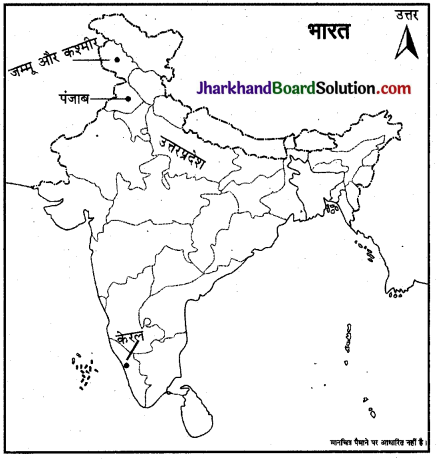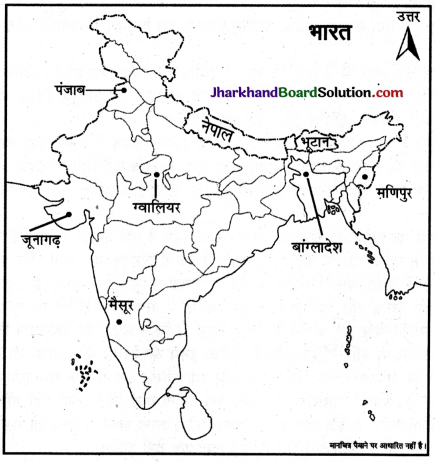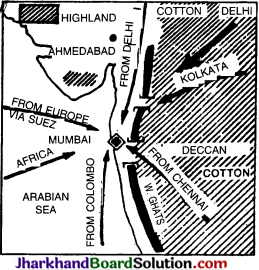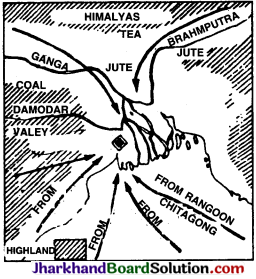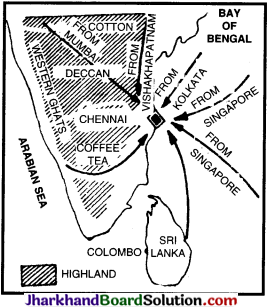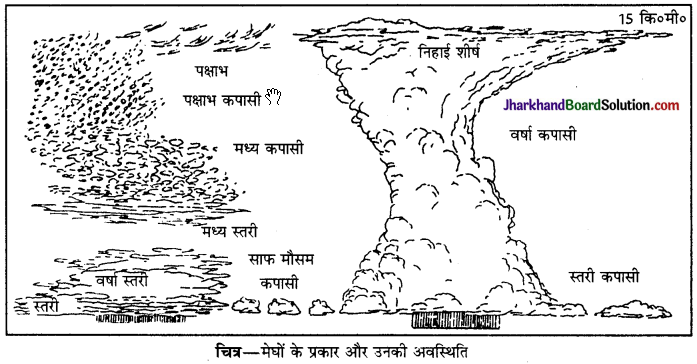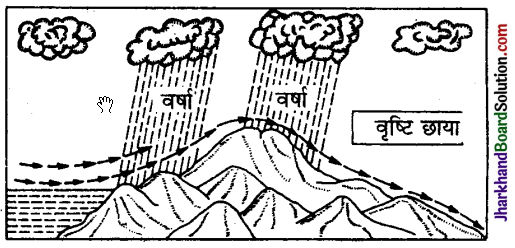Jharkhand Board JAC Class 12 History Important Questions Chapter 9 शासक और इतिवृत्त : मुगल दरबार Important Questions and Answers.
JAC Board Class 12 History Important Questions Chapter 9 शासक और इतिवृत्त : मुगल दरबार
बहुविकल्पीय प्रश्न (Multiple Choice Questions)
1. ‘मुगल’ की उत्पत्ति किस शब्द से हुई है –
(अ) महान
(स) मुसलमान
(ब) मंगोल
(द) मोगली
उत्तर:
(ब) मंगोल
2. किस मुगल सम्राट को शेरशाह से पराजित होकर ईरान भागना पड़ा?
(अ) बाबर
(ब) अकबर
(स) हुमायूँ
(द) जहाँगीर
उत्तर:
(स) हुमायूँ
3. मुगल साम्राज्य का संस्थापक था –
(अ) बाबर
(ब) हुमायूँ
(स) अकबर
(द) जहाँगीर
उत्तर:
(अ) बाबर

4. मुगल राजवंश का अन्तिम सम्राट कौन था?
(अ) मुअज्जम
(ब) फर्रुखसियर
(स) शाह आलम
(द) बहादुरशाह जफर द्वितीय
उत्तर:
(द) बहादुरशाह जफर द्वितीय
5. महाभारत का फारसी में अनुवाद किसके रूप में हुआ –
(अ) अकबरनामा
(ब) शाहीनामा
(स) एमनामा
(द) बाबरनामा
उत्तर:
(स) एमनामा
6. फारसी के हिन्दवी के साथ पारस्परिक सम्पर्क से किस नई भाषा का जन्म हुआ?
(ब) उर्दू
(द) संस्कृत
(अ) अरबी
(स) तुर्की
उत्तर:
(ब) उर्दू
7. नस्तलिक शैली के सबसे अच्छे सुलेखकों में से एक था –
(अ) रजा खाँ
(ब) इब्राहीम खाँ
(स) मन्सूर अली
(द) मुहम्मद हुसैन
उत्तर:
(द) मुहम्मद हुसैन

8. एशियाटिक सोसाइटी आफ बंगाल की स्थापना किसके द्वारा की गई?
(अ) जॉन मार्शल
(ब) मैकाले
(स) विलियम जोन्स
(द) कनिंघम
उत्तर:
(स) विलियम जोन्स
9. एशियाटिक सोसाइटी ऑफ बंगाल की स्थापना की गई –
(अ) 1784 ई.
(ब) 1794 ई.
(स) 1884 ई.
(द) 1795 ई.
उत्तर:
(अ) 1784 ई.
10. अकबर ने जजिया कर कब समाप्त कर दिया?
(अ) 1573
(ब) 1564
(द) 1579
(स) 1604
उत्तर:
(ब) 1564
11. मुगल पितृ पक्ष से निम्न में से किस तुर्की शासक के वंशज थे?
(अ) तिमूर
(ब) चंगेज खाँ
(स) मंगोल
(द) उपर्युक्त सभी
उत्तर:
(अ) तिमूर
12. रज्मनामा निम्नलिखित में से किस ग्रन्थ का फारसी अनुवाद है-
(अ) रामायण
(ब) लीलावती
(स) पंचतन्त्र
(द) महाभारत
उत्तर:
(द) महाभारत
13. नस्तलिक का सम्बन्ध निम्नलिखित में से किससे है?
(अ) एक ग्रन्थ
(ब) एक कविता
(स) सुलेखन शैली
(द) इनमें से कोई नहीं
उत्तर:
(स) सुलेखन शैली
14. निम्न में से किस मुगल दरबारी इतिहासकार ने चित्रकारी को एक जादुई कला के रूप में वर्णित किया है?
(अ) मुहम्मद हुसैन
(ब) अबुल फजल
(स) अब्दुल हमीद लाहौरी
(द) अब्दुल हसन
उत्तर:
(ब) अबुल फजल

15. 1560 के दशक में अकबर ने किस इमारत का निर्माण करवाया?
(अ) आगरा का किला
(ब) ताजमहल
(स) फतेहप्हपुर सीकरी
(द) सिकन्दर
उत्तर:
(अ) आगरा का किला
रिक्त स्थानों की पूर्ति कीजिए :
1. जंगल बुक …………… द्वारा लिखी गई है जिससे युवा नायक …………….. का नाम व्युत्पन्न हुआ है।
2. हुमायूँ ने सूरों को …………… में पराजित किया था।
3. अकबर का उत्तराधिकारी …………….. हुआ।
4. …………… मुगल वंश का अन्तिम मुगल शासक था।
5. अकबर, शाहजहाँ आलमगीर की कहानियों पर आधारित इतिवृत्तों के शीर्षक क्रमशः ……………. और …………. है।
6. चगताई तुर्क स्वयं को …………….. के सबसे बड़े पुत्र का वंशज मानते थे।
उत्तर:
1. रुडयार्ड किपलिंग, मोगली
2. 1555
3. जहाँगीर
4. बहादुरशाह जफर द्वितीय
5. अकबरनामा, शाहजहाँनामा, आलमगीरनामा
6. चंगेज खाँ।
अतिलघूत्तरात्मक प्रश्न
प्रश्न 1.
मुगल शासकों में सबसे महान कौन था?
उत्तर:
मुगल शासकों में अकबर सबसे महान था।
प्रश्न 2.
‘सिजदा तथा जमींबोसी ‘ का क्या अर्थ है?
उत्तर:
‘सिजदा’ का अर्थ बादशाह के सामने दंडवत लेटना तथा ‘जमींबोसी’ का अर्थ जमीन चूमना था।
प्रश्न 3.
कौन-सा किला सफावियों और मुगलों के बीच झगड़े का कारण रहा था?
उत्तर:
कन्धार का किला।
प्रश्न 4.
बादशाहनामा के दरबारी दृश्य में अंकित शान्तिपूर्वक चिपटकर बैठे हुए शेर एवं बकरी क्या संदेश देते हैं
उत्तर:
मुगल- राज्य में सबल तथा निर्बल परस्पर सद्भाव से रहते थे।
प्रश्न 5.
मुगल दरबार में प्रचलित अभिवादन के दो तरीकों का उल्लेख कीजिए।
उत्तर:
(1) सिजदा अथवा दण्डवत लेटना
(2) जमीं बरेसी (जमीन चूमना)।
प्रश्न 6.
फतेहपुर सीकरी का बुलन्द दरवाजा क्यों और किसने बनवाया?
उत्तर:
गुजरात में मुगल विजय की बाद में अकबर ने बुलन्द दरवाजा बनवाया।

प्रश्न 7.
मुगलकाल में पांडुलिपि रचना का मुख्य केन्द्र क्या कहलाता था?
उत्तर:
शाही किताबखाना।
प्रश्न 8.
‘मुगल’ नाम किस शब्द से व्युत्पन्न हुआ है?
उत्तर:
मंगोल।
प्रश्न 9.
मुगल किस मूल के वंशज थे और उनकी मातृ भाषा क्या थी?
उत्तर:
(1) चगताई तुर्क
(2) तुर्की भाषा।
प्रश्न 10.
मुगल शासक अपने को तैमूरी क्यों कहते थी?
उत्तर:
क्योंकि पितृ पक्ष से वे वंशज थे। तुर्की शासक तिमूर के
प्रश्न 11.
बावर मातृपक्ष से किसका सम्बन्धी था?
उत्तर:
चंगेज खाँ का।
प्रश्न 12.
मुगल साम्राज्य का संस्थापक कौन था?
उत्तर:
जहीरुद्दीन बाबर।
प्रश्न 13.
अकबर के तीन योग्य उत्तराधिकारियों के नाम लिखिए।
उत्तर:
(1) जहाँगीर
(2) शाहजहाँ
(3) औरंगजेब।
प्रश्न 14.
अकबर, शाहजहाँ, आलमगीर (औरंगजेब ) की कहानियों पर आधारित इतिवृत्तों के शीर्षक बताइये।
उत्तर:
(1) अकबरनामा
(2) शाहजहाँनामा
(3) आलमगीरनामा।
प्रश्न 15.
संस्कृत के दो ग्रन्थों के नाम लिखिए जिनका फारसी में अनुवाद करवाया गया।
उत्तर:
(1) रामायण
(2) महाभारत
प्रश्न 16.
चुगताई तुर्क कौन थे?
उत्तर:
मुगल

प्रश्न 17.
अकबर की पसंदीदा सुलेखन शैली कौनसी
उत्तर:
नस्तलिक।
प्रश्न 18.
अबुल फसल के अनुसार चित्रकारी का क्या महत्त्व था?
उत्तर:
चित्रकारी निर्जीव वस्तुओं में भी प्राण फूंक सकती थी।
प्रश्न 19.
ईरान से मुगल दरबार में आने वाले दो प्रसिद्ध चित्रकारों के नाम लिखिए।
उत्तर:
(1) मीर सैय्यद अली
(2) अब्दुस समद।
प्रश्न 20.
दो महत्त्वपूर्ण चित्रित मुगल इतिहासों के नाम लिखिए।
उत्तर:
(1) अकबरनामा
(2) बादशाहनामा।
प्रश्न 21.
एशियाटिक सोसाइटी ऑफ बंगाल की स्थापना का क्या उद्देश्य था?
उत्तर:
भारतीय पांडुलिपियों का सम्पादन, प्रकाशन और अनुवाद करना।
प्रश्न 22.
अबुल फसल के अनुसार बादशाह अपनी प्रजा के किन-किन सत्वों की रक्षा करते थे?
उत्तर:
मुगल सम्राट अपनी प्रजा के निम्न सत्त्वों की रक्षा करते थे-
(1) जीवन (जन),
(2) धन (माल),
(3) सम्मान (नामस)
(4) विश्वास (दीन)।
प्रश्न 23.
इन सवों की रक्षा के बदले में बादशाह अपनी प्रजा से क्या माँग करता था?
उत्तर:
(1) आज्ञापालन
(2) संसाधनों में हिस्से की
प्रश्न 24.
जजिया क्या था?
उत्तर:
जजिया एक कर था, जो गैर-मुसलमानों पर लगाया जाता था।
प्रश्न 25.
अकबर ने फतेहपुर सीकरी से राजधानी को कहाँ स्थानान्तरित किया और कब?
उत्तर:
1585 में अकबर ने राजधानी को लाहौर स्थानान्तरित किया।
प्रश्न 26.
मुगलकाल में दरबारियों के द्वारा बादशाह के अभिवादन के उच्चतम तरीके क्या थे?
उत्तर:
(1) सिजदा अथवा दण्डवत् लेटना
(2) चार तस्लीम
(3) जर्मी बोसी (जमीन चूमना )।

प्रश्न 27.
मुगल दरबार को किन चार अवसरों पर खूब सजाया जाता था?
उत्तर:
(1) सिंहासनारोहण की वर्षगांठ
(2) ईद
(3) शबे बरात
(4) होली। प्रश्न
प्रश्न 28.
औरंगजेब ने जयसिंह तथा जसवन्त सिंह
को किसकी पदवी प्रदान की थी?
उत्तर:
मिर्जा राजा।
प्रश्न 29.
मुगल सम्राट द्वारा दिए जाने वाले उपहारों (पुरस्कारों) का उल्लेख कीजिए।
उत्तर:
(1) सम्मान का जामा (खिल्लत)
(2) सरप्या
(3) रत्नजड़ित आभूषण।
प्रश्न 30.
शाहजहाँ की कौनसी पुत्रियों को ऊंचे शाही मनसबदारों के समान वार्षिक आय होती थी?
उत्तर-
(1) जहाँआरा
(2) रोशनआरा।
प्रश्न 31.
मुगल साम्राज्य के आरम्भ से ही कौन से अभिजात अकबर की शाही सेवा में उपस्थित थे?
उत्तर:
तूरानी और ईरानी अभिजात।
प्रश्न 32.
मुगलकाल में सभी सरकारी अधिकारियों के दर्जे और पदों में दो प्रकार के संख्या-विषयक पद कौनसे होते थे?
उत्तर:
(1) जात
(2) सवार
प्रश्न 33.
केन्द्रीय सरकार के दो महत्त्वपूर्ण मंत्रियों के नामोल्लेख कीजिए।
उत्तर:
(1) दीवाने आला (वित्तमंत्री)
(2) सद्र- उस- सुदूर (मदद-ए-माशा अथवा अनुदान का मन्त्री)
प्रश्न 34.
मुगलकाल में प्रान्तीय शासन के तीन प्रमुख अधिकारियों के नामोल्लेख कीजिए।
उत्तर:
(1) दीवान
(2) बख्शी
(3) सूबेदार।

प्रश्न 35.
मुगलकालीन परगनों के तीन अधिकारियों के नामोल्लेख कीजिए।
उत्तर:
(1) कानूनगो (राजस्व आलेख का रखवाला)
(2) चौधरी (राजस्व संग्रह का प्रभारी)
(3) काजी।
प्रश्न 36.
ईरानी सेना ने मुगलों के किस दुर्ग पर और कब अधिकार किया?
उत्तर:
1622 में कन्धार के दुर्ग पर
प्रश्न 37.
पहला जेसुइट शिष्टमण्डल फतेहपुर सीकरी के मुगल दरबार में कब पहुँचा?
उत्तर:
1580 ई. में
प्रश्न 38.
अकबर ने इबादतखाने का निर्माण कहाँ करवाया था?
उत्तर:
फतेहपुरी सीकरी में।
प्रश्न 39.
मुन्तखाब उत तवारीख’ की रचना किसने की थी?
उत्तर:
अब्दुल कादिर बदायूँनी ने
प्रश्न 40.
अकबर द्वारा निर्मित बुलन्द दरवाजा कहाँ स्थित है?
उत्तर:
फतेहपुर सीकरी में।
प्रश्न 41.
फतेहपुर सीकरी में शेख सलीम चिश्ती का मकबरा किस मुगल सम्राट ने बनवाया था?
उत्तर:
अकबर ने।
प्रश्न 42
आलमगीर की पदवी किसने धारण की
उत्तर:
औरंगजेब।
प्रश्न 43.
फारसी के हिन्दवी के साथ पारस्परिक सम्पर्क से किस भाषा की उत्पत्ति हुई?
उत्तर:
उर्दू।
प्रश्न 44.
‘बाबरनामा’ क्या है?
उत्तर:
‘बाबरनामा’ में बाबर के संस्मरण संकलित हैं।

प्रश्न 45.
फारसी को मुगल दरबार की भाषा बनाने वाला सम्राट कौन था?
उत्तर:
अकबर।
प्रश्न 46.
अकबर के शासनकाल में ‘महाभारत’ का -फारसी में किस नाम से अनुवाद हुआ?
उत्तर:
‘रक्मनामा’।
प्रश्न 47.
अबुल फजल ने चित्रकारी को किसकी संज्ञा दी है?
था।
उत्तर:
‘जादुई कला’ की।
प्रश्न 48.
बिहजाद कौन था?
उत्तर:
बिहजाद मुगलकाल का एक प्रसिद्ध चित्रकार
प्रश्न 49.
अकबर ने धार्मिक क्षेत्र में कौनसी नीति अपनाई थी?
उत्तर:
सुलह-ए-कुल।
प्रश्न 50.
‘सुलह-ए-कुल’ का क्या अर्थ है?
उत्तर:
पूर्ण शान्ति।
प्रश्न 51.
अकबर के पश्चात् किस मुगल सम्राट ने हिन्दुओं पर जजिया कर पुनः लगा दिया?
उत्तर:
औरंगजेब ने।
प्रश्न 52.
पीड़ित लोगों को निष्पक्षतापूर्वक न्याय दिलाने के लिए अपने महल में न्याय की जंजीर लगाने वाला मुगल सम्राट कौन था?
उत्तर:
जहाँगीर।
प्रश्न 53.
झरोखा दर्शन की प्रथा किस मुगल सम्राट ने शुरू की थी?
उत्तर:
अकबर ने
प्रश्न 54.
कोर्निश का क्या अर्थ है?
उत्तर:
कोर्निश दरबार में औपचारिक अभिवादन का एक तरीका था।
प्रश्न 55.
शाहजहाँ ने कब और किसे अपनी राजधानी बनाया?
उत्तर:
1648 में शाहजहाँ ने शाहजहाँनाबाद को अपनी राजधानी बनाया।

प्रश्न 56.
शाहजहाँ द्वारा निर्मित तीन इमारतों के नाम लिखिए।
उत्तर:
(1) लाल किला (दिल्ली)
(2) जामा मस्जिद (दिल्ली)
(3) ताजमहल (आगरा)।
प्रश्न 57.
हरम शब्द का क्या अर्थ है?
उत्तर:
‘पवित्र स्थान’ मुगलों का अन्तःपुर हरम कहलाता था।
प्रश्न 58.
मुगल परिवार में ‘अगाचा’ कौन होती थीं?
उत्तर:
मुगल सम्राटों की उप-पत्नियाँ।
प्रश्न 59.
‘हुमायूँनामा’ की रचना किसने की थी?
उत्तर:
गुलबदन ने।
प्रश्न 60.
अकबर की शाही सेवा में नियुक्त होने वाला प्रथम व्यक्ति कौनसा राजपूत मुखिया था?
उत्तर:
भारमल कछवाहा।
प्रश्न 61.
अकबर के साथ सर्वप्रथम किस राजपूत नरेश ने अपनी पुत्री का विवाह किया था?
उत्तर:
आम्बेर के राजा भारमल कछवाहा ने।
प्रश्न 62.
टोडरमल कौन था?
उत्तर:
टोडरमल अकबर का वित्तमन्त्री था
प्रश्न 63.
मीरबख्शी कौन था?
उत्तर:
यह सैन्य विभाग का मन्त्री था।
प्रश्न 64.
मुगलों के केन्द्रीय शासन के दो प्रमुख मन्त्रियों का उल्लेख कीजिये।
उत्तर:
(1) दीवान-ए-आला
(2) सद्र-उस- सुदूर

प्रश्न 65.
मुगलकाल में प्रान्त का प्रमुख क्या कहलाता
उत्तर:
सूबेदार
प्रश्न 66.
मुगल काल में प्रत्येक सूबा किनमें विभाजित
उत्तर:
सरकारों में।
प्रश्न 67.
अकबर ने कन्धार के दुर्ग पर कब अधिकार स्थापित किया था?
उत्तर:
1595 ई. में
प्रश्न 68.
ईरानियों और मुगलों के बीच विवाद का मुख्य कारण क्या था?
उत्तर:
कन्धार पर अधिकार करना।
प्रश्न 69.
मुगलकाल में सिजदा के महत्व का उल्लेख कीजिये।
उत्तर:
‘अकबरनामा’ का लेखक अबुल फसल तथा ‘बादशाहनामा’ का लेखक अब्दुल हमीद लाहौरी था।
प्रश्न 79.
अबुल फजल के अनुसार सुलह-ए-कुल क्या था?
उत्तर:
अबुल फसल सुलह-ए-कुल के आदर्श को प्रबुद्ध शासन की आधारशिला मानता था।
प्रश्न 80.
सुलह-ए-कुल की नीति के अन्तर्गत अकबर द्वारा किए गए दो उपायों का उल्लेख कीजिए।
उत्तर:
अकबर ने 1563 में तीर्थयात्रा कर तथा 1564 में जजिया कर समाप्त कर दिया।
प्रश्न 81.
सुलह-ए-कुल का क्या आदर्श था?
उत्तर:
साम्राज्य के सभी धार्मिक तथा नृजातीय समूहों के लोगों के बीच शान्ति, सद्भावना और एकता बनाये रखना।
प्रश्न 82.
राज्यारोहण के बाद जहाँगीर ने पहला आदेश क्या दिया था?
उत्तर:
न्याय की जंजीर को लगाने का ताकि पीड़ित व्यक्ति जंजीर हिलाकर जहाँगीर का ध्यान आकर्षित कर सकें।
प्रश्न 83.
अकबर द्वारा बनाई गई राजधानियों के नाम लिखिए।
उत्तर:
(1) आगरा
(2) फतेहपुरी सीकरी
(3) लाहौर।
प्रश्न 84.
अकबर ने कब और किसे अपनी राजधानी बनाया?
उत्तर:
1570 के दशक में अकबर ने फतेहपुरी सीकरी को अपनी राजधानी बनाया।

प्रश्न 85.
झरोखा दर्शन की प्रथा का क्या उद्देश्य था?
उत्तर:
जन विश्वास के रूप में शाही सत्ता की स्वीकृति को और विस्तार देना।
प्रश्न 86.
दीवान-ए-आम से क्या अभिप्राय है?
उत्तर:
दीवान-ए-आम सार्वजनिक सभा भवन था जहाँ राज्य के प्रमुख अधिकारी अपनी रिपोर्ट और प्रार्थना-पत्र प्रस्तुत करते थे।
प्रश्न 87.
‘दीवान-ए-खास’ क्या था?
उत्तर:
मुगल सम्राट दीवान-ए-खास नामक भवन में राज्य के वरिष्ठ मन्त्रियों से गोपनीय मुद्दों पर चर्चा करते थे। प्रश्न 88. मुगल सम्राट वर्ष में कौन-से तीन मुख्य त्यौहार मनाते थे?
उत्तर:
(1) सूर्य वर्ष के अनुसार सम्राट का जन्म दिन
(2) चन्द्र वर्ष के अनुसार सम्राट का जन्म दिन तथा
(3) फारसी नव वर्ष (नौ रोज)।
प्रश्न 89.
मुगल सम्राटों द्वारा अपने अमीरों को दी जाने वाली प्रमुख पदवियों का उल्लेख कीजिए।
उत्तर:
प्रश्न 90.
(1) आसफ खाँ
(2) मिर्जा राजा।मुगल परिवार में बेगम और अगहा महिलाएँ कौन होती थीं?
उत्तर:
(1) शाही परिवारों से आने वाली महिलाएँ ‘बेगम’ कहलाती थीं।
(2) कुलीन परिवार में जन्म न लेने वाली महिलाएँ ‘अगहा’ कहलाती थीं।

प्रश्न 91.
गुलबदन बेगम कौन थी?
उत्तर:
गुलबदन बेगम बाबर की पुत्री, हुमायूँ की बहिन तथा अकबर की बुआ थी।
प्रश्न 92.
अभिजात कौन थे?
उत्तर:
मुगल राज्य के अधिकारियों का दल अभिजात- वर्ग कहलाता था।
प्रश्न 93.
आप ‘जात’ व ‘सवार’ से क्या समझते हैं? स्पष्ट करें।
उत्तर:
‘जात’ मनसबदार के पद, वेतन का सूचक था तथा ‘सवार’ यह सूचित करता था कि उसे कितने घुड़सवार रखने थे।
प्रश्न 94.
मीरबख्शी का क्या कार्य था?
उत्तर:
वह शाही सेवा में नियुक्ति तथा पदोन्नति के सभी उम्मीदवारों को मुगल सम्राट के सामने प्रस्तुत करता था।
प्रश्न 95.
‘तैनात ए-रकांब’ से आप क्या समझते हैं?
उत्तर:
यह अभिजातों का ऐसा सुरक्षित दल था जिसे किसी भी प्रान्त या सैन्य अभियान में प्रतिनियुक्त किया जा सकता था।
प्रश्न 96.
दरबारी लेखक या वाकिया नवीस कौन थे?
उत्तर:
दरबारी लेखक दरबार में प्रस्तुत किये जाने वाले सभी प्रार्थना-पत्रों, दस्तावेजों तथा शासकीय आदेशों का आलेख तैयार करते थे।

प्रश्न 97.
नस्तलिक शैली से क्या अभिप्राय है?
उत्तर:
नस्तलिक शैली एक ऐसी शैली थी जिसे लम्बे सपाट प्रवाही ढंग से लिखा जाता था।
लघुत्तरात्मक प्रश्न-
प्रश्न 1.
जलालुद्दीन अकबर को मुगल बादशाहों में महानतम क्यों माना जाता है?
उत्तर:
जलालुद्दीन अकबर को (1556-1605) को मुगल बादशाहों में महानतम माना जाता है क्योंकि उसने न केवल मुगल साम्राज्य का विस्तार ही किया, बल्कि इसे अपने समय का विशालतम दृढ़तम तथा सबसे समृद्ध राज्य भी बना दिया। अकबर ने हिन्दूकुश पर्वत तक अपने साम्राज्य की सीमाओं का विस्तार किया। उसने ईरान के सफावियों और तूरान (मध्य एशिया) के उजबेकों की विस्तारवादी योजनाओं पर अंकुश लगाए रखा। उसने 1595 में कन्धार पर अधिकार कर लिया।
प्रश्न 2.
सुलेखन का क्या महत्त्व था?
उत्तर:
सुलेखन अर्थात् हाथ से लिखने की कला अत्यन्त महत्त्वपूर्ण कौशल मानी जाती थी। इसका प्रयोग भिन्न- भिन्न शैलियों में होता था ‘नस्तलिक’ अकबर की मनपसन्द शैली थी। यह एक ऐसी तरल शैली थी जिसे लम्बे सपाट प्रवाही ढंग से लिखा जाता था। इसे 5 से 10 मिलीमीटर की नोक वाले छटे हुए सरकंडे के टुकड़े से स्याही में डुबोकर लिखा जाता था।
प्रश्न 3.
मुगल पांडुलिपियों में चित्रों के समावेश का क्या महत्त्व था?
उत्तर:
(1) चित्र पुस्तक के सौन्दर्य में वृद्धि करते हैं।
(2) जहाँ लिखित माध्यम से राजा और राजा की शक्ति के विषय में जो बात कही न जा सके, उन्हें चित्रों के माध्यम से व्यक्त किया जा सकता था।
(3) अबुल फजल के अनुसार चित्रकला एक जादुई कला थी। उसकी राय में चित्रकला किसी निर्जीव वस्तु में भी प्राण फूँक सकती थी।
प्रश्न 4.
“अबुल फजल ने न्यायपूर्ण सम्प्रभुता को एक सामाजिक अनुबन्ध के रूप में परिभाषित किया है।” व्याख्या कीजिए।
उत्तर:
अबुल फजल के अनुसार बादशाह अपनी प्रजा के चार सत्वों की रक्षा करता है-
(1) जीवन (जन),
(2) धन (मूल्य),
(3) सम्मान (नामस),
(4) विश्वास (दीन)।
इसके बदले में वह आज्ञापालन तथा संसाधनों में हिस्से की माँग करता है। केवल न्यायपूर्ण सम्प्रभु ही शक्ति और दैवीय मार्गदर्शन के साथ इस सामाजिक अनुबन्ध का सम्मान कर पाते थे।
प्रश्न 5.
मुगल काल में न्याय के विचार को दृश्य रूप में किन प्रतीकों के माध्यम से निरूपित किया गया? इसका क्या उद्देश्य था?
उत्तर:
मुगल राजतंत्र में न्याय के विचार को सर्वोत्तम सद्गुण माना गया। कलाकारों द्वारा प्रयुक्त सर्वाधिक मनपसन्द प्रतीकों में से एक था. एक-दूसरे के साथ चिपटकर शान्तिपूर्वक बैठे हुए शेर और बकरी अथवा शेर और गाय इसका उद्देश्य राज्य को एक ऐसे क्षेत्र के रूप में दर्शाना था जहाँ दुर्बल तथा सबल सभी परस्पर सद्भाव से रह सकते थे।

प्रश्न 6.
अकबर ने फतेहपुर सीकरी को अपनी राजधानी बनाने का निश्चय क्यों किया?
उत्तर:
अकबर ने फतेहपुर सीकरी को अपनी राजधानी बनाने का निश्चय किया। इसका कारण यह था कि फतेहपुर | सीकरी अजमेर को जाने वाली सीधी सड़क पर स्थित थी,
जहाँ शेख मुइनुद्दीन चिश्ती की दरगाह उस समय तक एक महत्त्वपूर्ण तीर्थ स्थल बन चुकी थी। मुगल बादशाहों के चिश्ती सिलसिले के सूफियों के साथ अच्छे सम्बन्ध थे।
प्रश्न 7.
राज्यारोहण के बाद जहाँगीर द्वारा दिए गए पहले आदेश का उल्लेख कीजिए।
उत्तर:
राज्यारोहण के बाद जहाँगीर ने जो पहला आदेश दिया, वह न्याय की जंजीर लगाने का था। इसका कारण यह था कि यदि न्याय करने वाले अधिकारी न्याय करने में देरी करें अथवा वे न्याय चाहने वाले लोगों के विषय में मिथ्याचार करें तो उत्पीड़ित व्यक्ति इस जंजीर को हिलाकर बादशाह का ध्यान आकृष्ट कर सकता था। इस जंजीर को शुद्ध सोने से बनाया गया था। यह 30 गज लम्बी थी तथा इसमें 60 पटयाँ लगी हुई थीं।
प्रश्न 8.
शाहजहाँ द्वारा किसे शाही राजधानी बनाया गया? उसका संक्षिप्त उल्लेख कीजिए।
उत्तर:
1648 में शाहजहाँ ने शाहजहांनाबाद को नई शाही राजधानी बनाया। दिल्ली के प्राचीन रिहायशी नगर में शाहजहाँनाबाद एक नई और शाही आबादी थी। यहाँ लाल किला, जामा मस्जिद, चांदनी चौक के बाजार की वृक्षवीथि और अभिजात वर्ग के बड़े-बड़े घर थे। शाहजहाँनाबाद विशाल एवं भव्य मुगल राजतंत्र की औपचारिक कल्पना को व्यक्त करता था।
प्रश्न 9.
‘कोर्निश’ से क्या अभिप्राय है?
उत्तर:
मुगल काल में ‘कोर्निश’ औपचारिक अभिवादन का एक ऐसा तरीका था, जिसमें दरबारी दाएँ हाथ की तलहधी को ललाट पर रखकर आगे की ओर सिर झुकाते थे। यह इस बात का प्रतीक था कि कोर्निश करने वाला व्यक्ति अपने इन्द्रिय और मन के स्थल को हाथ लगाते हुए शुककर विनम्रतापूर्वक शाही दरबार में अपने को प्रस्तुत कर रहा था।
प्रश्न 10.
मुगल अभिजात वर्गों के बीच हैसियत को निर्धारित करने वाले नियमों का उल्लेख कीजिए।
उत्तर:
दरबार में अभिजात वर्ग के किसी व्यक्ति की हैसियत इस बात से निर्धारित होती थी कि वह बादशाह के कितना पास और दूर बैठा है। किसी भी दरबारी को बादशाह द्वारा दिया गया स्थान बादशाही की दृष्टि में उसकी महत्ता का प्रतीक था। बादशाह को किए गए अभिवादन के तरीके से पदानुक्रम में उस व्यक्ति की हैसियत का पता चलता था।
प्रश्न 11.
भारत में मुगल राजवंश का अन्त कैसे हुआ?
उत्तर:
1707 ई. में औरंगजेब की मृत्यु के पश्चात् मुगल राजवंश की शक्ति घट गई। अतः विशाल मुगल साम्राज्य के स्थान पर कई क्षेत्रीय शक्तियाँ उभर आई, फिर भी सांकेतिक रूप से मुगल शासक की प्रतिष्ठा बनी रही। 1857 ई. में इस वंश के अन्तिम शासक बहादुरशाह जफर द्वितीय को अंग्रेजों ने उखाड़ फेंका इस प्रकार मुगल राजवंश का अन्त हो गया।
प्रश्न 12.
मुगल बादशाहों द्वारा तैयार करवाए गए इतिवृत्तों के कोई दो उद्देश्य लिखिए।
उत्तर:
मुगल बादशाहों द्वारा तैयार करवाए गए इतिवृत्तों के प्रमुख दो उद्देश्य निम्नलिखित थे.
(i) मुगल साम्राज्य के अन्तर्गत आने वाले समस्त लोगों के समक्ष मुगल राज्य को एक प्रबुद्ध राज्य के रूप में चित्रित करना।
(ii) मुगल शासन का विरोध करने वाले लोगों को यह बताना कि उनके सभी विरोधों का असफल होना निश्चित है।
प्रश्न 13.
न्याय की जंजीर किस बादशाह द्वारा लगवाई गई?
उत्तर:
न्याय की जंजीर जहाँगीर नामक बादशाह के द्वारा लगवाई गयी जो अपनी न्यायप्रियता के लिए बहुत प्रसिद्ध था जहाँगीर ने सिंहासन पर आरूढ़ होने के बाद सबसे पहला आदेश न्याय की जंजीर लगाने के सम्बन्ध में दिया। कोई भी व्यक्ति जिसे प्रशासन से न्याय न मिले, वह सीधे इस जंजीर को हिलाकर सम्बद्ध घण्टे को बजाकर न्याय की फरियाद बादशाह से कर सकता था। इस जंजीर को विशुद्ध रूप से सोने से बनाया गया था यह 30 गज लम्बी थी तथा इसमें 60 घण्टियाँ लगी हुई थीं।

प्रश्न 14.
मुगल काल में अभिवादन का ‘चार तसलीम’ तरीका क्या था?
उत्तर:
मुगल काल में अभिवादन का ‘चार तसलीम’ तरीका दाएँ हाथ को जमीन पर रखने से शुरू होता था। इसमें तलहथी ऊपर की ओर होती थी। इसके बाद हाथ को धीरे-धीरे उठाते हुए व्यक्ति खड़ा होता था तथा तलहथी को सिर के ऊपर रखता था ऐसी तसलीम चार बार की जाती थी। तसलीम का शाब्दिक अर्थ आत्मनिवेदन है।
प्रश्न 15.
मुगल दरबार में राजनयिक दूत सम्बन्धी नयाचारों का उल्लेख कीजिए।
उत्तर:
मुगल बादशाह के समक्ष प्रस्तुत होने वाले राजदूत से यह अपेक्षा की जाती थी कि वह अभिवादन के मान्य रूपों में से एक या तो बहुत झुककर अथवा जमीन को चूमकर अथवा फारसी रिवाज के अनुसार छाती के सामने हाथ बाँधकर तरीके से अभिवादन करेगा। अंग्रेज राजदूत टामस रो ने यूरोपीय रिवाज के अनुसार जहाँगीर के सामने केवल झुककर अभिवादन किया और बैठने के लिए कुर्सी का आग्रह किया।
प्रश्न 16.
शब-ए-बारात’ पर संक्षिप्त टिप्पणी लिखिए।
उत्तर:
शब-ए-बारात हिजरी कैलेंडर के आठवें महीने अर्थात् चौदहवें सावन को पड़ने वाली पूर्ण चन्द्ररात्रि है। भारतीय उपमहाद्वीप में प्रार्थनाओं और आतिशबाजियों के खेल द्वारा इस दिन को मनाया जाता है। ऐसा माना जाता है कि इस रात मुसलमानों के लिए आगे आने वाले वर्ष का भाग्य निर्धारित होता है और पाप माफ कर दिए जाते हैं।
प्रश्न 17.
सम्मान का जामा’ तथा ‘सरप्पा’ नामक पुरस्कार क्या थे?
उत्तर:
योग्य व्यक्तियों को मुगल सम्राटों द्वारा पुरस्कार दिए जाते थे। इन पुरस्कारों में ‘सम्मान का जामा’ (खिल्लत) भी शामिल था जिसे पहले कभी न कभी बादशाह द्वारा पहना गया हुआ होता था इसलिए यह समझा जाता था कि वह बादशाह के आशीर्वाद का प्रतीक था ‘सरप्पा’ (सर से पाँव तक) एक अन्य उपहार था इस उपहार के तीन हिस्से हुआ करते थे- जामा, पगड़ी और पटका।

प्रश्न 18.
‘शाही परिवार’ से क्या अभिप्राय है?
उत्तर:
‘हरम’ शब्द का प्रयोग प्राय: मुगलों की घरेलू दुनिया की ओर संकेत करता है। यह शब्द फारसी से निकला है जिसका तात्पर्य है पवित्र स्थान’ मुगल परिवार (शाही) में बादशाह की पत्नियों और उपपत्नियाँ, उसके निकटस्थ और दूर के सम्बन्धी (माता, सौतेली व उपमाताएँ. बहन, पुत्री, बहू, चाची-मौसी, बच्चे आदि) व महिला परिचारिकाएँ तथा गुलाम होते थे।
प्रश्न 19.
‘जात’ और ‘सवार’ मनसबदार से क्या अभिप्राय है?
उत्तर:
मुगल काल में सभी सरकारी अधिकारियों के दर्जे और पदों में दो तरह के संख्या-विषयक पद होते थे। ‘जात’ शाही पदानुक्रम में अधिकारी ( मनसबदार) के पद और वेतन का सूचक था और ‘सवार’ यह सूचित करता था कि उससे सेवा में कितने घुड़सवार रखना अपेक्षित था। सत्रहवीं शताब्दी में 1000 या उससे ऊपर जात वाले मनसबदार अभिजात ‘उमरा’ कहलाते थे।
हैं?
प्रश्न 20.
‘तैनात ए रकाब से आप क्या समझते
उत्तर:
भुगल दरबार में नियुक्त ‘तैनात ए रकाब ‘ अभिजातों का एक ऐसा सुरक्षित दल था, जिसे किसी भी प्रान्त या सैन्य अभियान में प्रतिनियुक्त किया जा सकता था। ये प्रतिदिन दो बार सुबह व शाम को सार्वजनिक सभा- भवन में बादशाह के प्रति आत्मनिवेदन करने के लिए उपस्थित होते थे। वे दिन-रात बादशाह और उसके घराने की सुरक्षा का दायित्व भी वहन करते थे।
प्रश्न 21.
अब्दुल कादिर बदायूँनी द्वारा ‘हरम में होम’ का वर्णन किस प्रकार किया है?
उत्तर:
‘अब्दुल कादिर बदायूँनी ने लिखा है कि युवावस्था के आरम्भ से ही, मुगल सम्राट अकबर अपनी पत्नियों अर्थात् भारत के राजाओं की पुत्रियों के सम्मान में ‘हरम में होम’ का आयोजन कर रहे थे। यह ऐसी धर्मक्रिया थी जो अग्नि पूजा (आतिश-परस्ती) से उत्पन्न हुई थी परन्तु अपने 25वें शासन वर्ष ( 1578) के नए वर्ष पर उसने सार्वजनिक रूप से सूर्य और अग्नि को दंडवत् प्रणाम किया।
प्रश्न 22.
मुगल सम्राट अपने राजवंश का इतिहास क्यों लिखवाना चाहते थे?
उत्तर:
मुगल सम्राटों की यह मान्यता थी कि उन्हें एक विशाल एवं विजातीय जनता पर शासन के लिए स्वयं ईश्वर ने नियुक्त किया है। ऐसा दृष्टिकोण सदैव महत्त्वपूर्ण बना रहा। इस दृष्टिकोण के प्रचार-प्रसार का एक तरीका राजवंशीय इतिहास लिखना लिखवाना था। अतः मुगल सम्राटों ने दरबारी इतिहासकारों को विवरण लिखने का कार्य सौंपा। इन विवरणों में मुगल सम्राटों के समय की घटनाओं का लेखा-जोखा प्रस्तुत किया गया।
प्रश्न 23.
मुगल इतिवृत्त / इतिहास के महत्त्व पर प्रकाश डालिए।
उत्तर:
मुगल इतिवृत्त घटनाओं का काल क्रमानुसार विवरण प्रस्तुत करते हैं। मुगलों का इतिहास लिखने के इच्छुक विद्वानों के लिए ये इतिवृत्त अनिवार्य स्रोत हैं। एक ओर तो ये इतिवृत्त मुगल साम्राज्य की संस्थाओं के बारे में तथ्यात्मक सूचनाएँ प्रदान करते थे, तो दूसरी ओर ये उन उद्देश्यों का प्रसार करते थे जिन्हें मुगल सम्राट अपने क्षेत्र में लागू करना चाहते थे। ये इतिवृत्त यह प्रकट करते हैं कि शाही विचारधाराएँ कैसे रची तथा प्रसारित की जाती थीं।

प्रश्न 24.
खिल्लत, सरण्या, पद्म मुरस्सा आदि उपहारों से आप क्या समझते हैं?
उत्तर:
मुगल सम्राटों द्वारा योग्य व्यक्तियों को पदवियाँ और पुरस्कार प्रदान कर सम्मानित किया जाता था खिल्लत पुरस्कार में बादशाह अपने द्वारा पहना हुआ जामा उपहारस्वरूप देता था। इसे बादशाह के आशीर्वाद का प्रतीकं समझा जाता था सरप्पा, सिर से पाँव तक का उपहार होता था। इसमें जामा, पगड़ी और पटका शामिल होते थे। बादशाह द्वारा उपहार में दिए गए कमल की मंजरियों वाले रत्नजड़ित गहनों के सेट को पद्म मुरस्सा कहा जाता था।
प्रश्न 25.
मुगल वास्तुकला में जहाँआरा के योगदान पर संक्षिप्त टिप्पणी लिखिए।
उत्तर:
जहाँआरा मुगल बादशाह शाहजहाँ की पुत्री थी। उसने शाहजहाँ की नई राजधानी शाहजहाँनाबाद (दिल्ली) की कई वास्तुकलात्मक परियोजनाओं में भाग लिया। इनमें से आँगन एवं बाग के साथ एक दोमंजिली भव्य कारवाँ सराय थी। शाहजहाँनाबाद के मुख्य केन्द्र चाँदनी चौक की रूपरेखा भी जहाँआरा द्वारा बनाई गई थी।
प्रश्न 26.
सरकारी अधिकारियों के दर्जे जात, मनसबदार, उमरा आदि से आपका क्या तात्पर्य सवार, है?
उत्तर:
सरकारी अधिकारियों के दर्जे और पदों में दो तरह के ओहदे होते थे। यह ओहदे संख्या विषयक होते थे। शाही पदानुक्रम में जात अधिकारी जिसे मनसबदार कहा जाता था, के पद और वेतन को सूचित करता था और ‘सवार’ से यह सूचित होता था कि वह कितने घुड़सवार रख सकता था। 1000 या उससे ऊपर जात वाले मनसबदार ‘उमरा’ जो कि अमीर का बहुवचन है, कहे जाते थे।
प्रश्न 27.
मीर बख्शी कौन था? मीर बख्शी तथा उसका कार्यालय क्या कार्य करता था?
उत्तर:
मुगलकाल में मीर बख्शी सर्वोच्च वेतनदाता था। मीर बख्शी खुले दरबार में बादशाह के दायीं ओर खड़ा रहकर नियुक्ति तथा पोदन्नति पाने वाले उम्मीदवारों को प्रस्तुत करता था उसका कार्यालय उसकी मुहर एवं हस्ताक्षर के साथ-साथ बादशाह की मुहर तथा हस्ताक्षर वाले आदेश भी तैयार करता था।
प्रश्न 28.
मुगल कौन थे?
उत्तर:
‘मुगल’ शब्द की उत्पत्ति ‘मंगोल’ से हुई है। मुगल शासकों ने अपने को ‘तैमूरी’ कहा क्योंकि पितृपक्ष से वे तुर्की शासक तिमूर के वंशज थे प्रथम मुगल शासक बाबर मातृपक्ष से चंगेजखों का सम्बन्धी था। वह तुर्की भाषा बोलता था। मुगल चगताई मूल के थे तथा तुर्की उनकी मातृभाषा थी। सोलहवीं शताब्दी में यूरोपियों ने मुगल राजवंश के लिए मुगल शब्द का प्रयोग किया था उस समय से ही इस शब्द का निरन्तर प्रयोग होता रहा है।
प्रश्न 29.
” मुगल बादशाहों द्वारा तैयार करवाए गए इतिवृत्त साम्राज्य और उसके दरबार के अध्ययन के महत्त्वपूर्ण स्त्रोत हैं।” व्याख्या कीजिए।
अथवा
इतिवृत्त किस प्रकार मुगल सम्राटों के विषय में महत्त्वपूर्ण जानकारी प्रदान करते हैं?
उत्तर:
मुंगल सम्राटों द्वारा तैयार करवाए गए इतिवृत्त साम्राज्य और उसके दरबार के अध्ययन के महत्त्वपूर्ण खोत हैं। ये इतिवृत्त मुगल साम्राज्य के अन्तर्गत आने वाले सभी लोगों के सामने मुगल- राज्य को एक प्रबुद्ध राज्य के रूप में दर्शाने के उद्देश्य से लिखे गए थे। इसी प्रकार उनका उद्देश्य मुगल शासन का विरोध करने वाले लोगों को यह भी बताना था कि उनके सभी विरोधों का असफल होना निश्चित है। मुगल सम्राट यह भी चाहते थे कि भावी पीढ़ियों के लिए उनके शासन के विवरण उपलब्ध रहे।

प्रश्न 30.
“मुगल इतिवृत्तों के लेखक निरपवाद रूप से दरबारी ही रहे।” व्याख्या कीजिये।
उत्तर:
मुगल इतिवृत्तों में शासक पर केन्द्रित घटनाओं, शासक के परिवार दरबार व अभिजात वर्ग, बुद्ध और प्रशासनिक व्यवस्थाओं का समावेश था। अकबर, शाहजहाँ तथा आलमगीर (औरंगजेब) के शासन काल की घटनाओं पर आधारित इतिवृत्तों के शीर्षक ‘अकबरनामा’, ‘शाहजहाँनामा’ तथा ‘आलमगीरनामा’ यह संकेत देते हैं कि इनके लेखकों की दृष्टि में साम्राज्य एवं दरबार का इतिहास और बादशाह का इतिहास एक ही था।
प्रश्न 31.
अकबर ने फारसी को दरबार की मुख्य भाषा क्यों बनाया?
उत्तर:
अकबर ने सोच समझकर फारसी को दरबार की मुख्य भाषा बनाया। सम्भवतया ईरान के साथ सांस्कृतिक और बौद्धिक सम्पर्कों के साथ-साथ मुगल दरबार में पद पाने को इच्छुक ईरानी और मध्य एशियाई प्रवासियों ने अकबर को फारसी भाषा को अपनाए जाने के लिए प्रेरित किया होगा। फारसी को दरबार की भाषा का ऊंचा स्थान दिया गया तथा उन लोगों को शक्ति तथा प्रतिष्ठा प्रदान की गई, जिनका इस भाषा पर अच्छा नियंत्रण था।
प्रश्न 32.
मुगल पाण्डुलिपियों में चित्रों को किस प्रकार संलग्न किया जाता था?
उत्तर:
मुगल पांडुलिपियों की रचना में चित्रकारों का भी महत्त्वपूर्ण योगदान था। किसी मुगल सम्राट के शासन की घटनाओं का विवरण देने वाले इतिहासों में लिखित पाठ के साथ ही उन घटनाओं को चित्रों के माध्यम से दृश्य रूप में भी वर्णित किया जाता था जब किसी पुस्तक में घटनाओं अथवा विषयों को दृश्य रूप में वर्णित किया जाना होता था, तो सुलेखक उसके आस-पास के पृष्ठों को खाली छोड़ देते थे। चित्रकार शब्दों में वर्णित विषय को अलग से चित्र के रूप में उतारकर वहाँ संलग्न कर देते थे।
प्रश्न 33.
मुगल पाण्डुलिपियों में चित्रों को संलग्न करने का क्या महत्त्व था?
उत्तर:
पाण्डुलिपियों में चित्रों का महत्त्व-
(1) चित्र पुस्तक के सौन्दर्य में वृद्धि करते थे।
(2) राजा और उसकी शक्ति के बारे में जो बात लिखित रूप से नहीं कही जा सकती थी, उसे चित्र व्यक्त कर देते थे।
(3) अबुल फजल ने चित्रकारी को एक ‘जादुई कला’ की संज्ञा दी है उसके अनुसार चित्रकला किसी निर्जीव वस्तु को भी सजीव रूप प्रदान कर सकती है।
प्रश्न 34.
मुगल सम्राट तथा उसके दरबार का चित्रण करने वाले चित्रों की रचना को लेकर शासकों और उलमा के बीच तनाव की स्थिति क्यों बनी रहती थी?
उत्तर:
उलमा रूढ़िवादी मुसलमान वर्ग के प्रतिनिधि थे। उन्होंने कुरान के साथ-साथ हदीस में प्रतिष्ठापित मानव रूपों के चित्रण पर इस्लामी प्रतिबन्ध का आह्वान किया। हदीस में एक प्रसंग में पैगम्बर साहब को प्राकृतिक तरीके से जीवित रूपों के चित्रण की मनाही करते हुए उल्लिखित किया गया है। इसका कारण यह है कि ऐसा करने से यह लगता था कि कलाकार रचना की शक्ति को अपने हाथ में लेने का प्रयास कर रहा है। यह केवल ईश्वर का ही कार्य था।

प्रश्न 35.
मुगल शासनकाल की पांडुलिपियों में चित्रों को किस प्रकार संलग्न किया जाता था?
उत्तर:
मुगल शासनकाल की पांडुलिपियों की रचनाओं में चित्रकारों का भी बहुत महत्त्वपूर्ण योगदान था। किसी मुगल बादशाह के शासन की घटनाओं का विवरण देने वाले इतिहासों में लिखित पाठ के साथ-साथ उन घटनाओं को चित्रों के माध्यम से दृश्य रूप में दर्शाया जाता था। जब किसी पुस्तक में घटनाओं अथवा विषयों को दृश्य रूप में व्यक्त किया जाना होता था तो सुलेखक उसके आसपास के पृष्ठों को खाली छोड़ देते थे। चित्रकार शब्दों में वर्णित विषय को अलग से चित्रों में उतारकर वहाँ संलग्न कर देते थे। ये लघु चित्र होते थे जिन्हें पांडुलिपि के पृष्ठों पर आसानी से लगाया और देखा जा सकता था।
प्रश्न 36.
दैवीय प्रकाश से आप क्या समझते हैं? दरबारी इतिहासकारों ने इसकी व्याख्या कैसे की?
उत्तर:
मुगल दरबार के इतिहासकारों ने मुगल सम्राटों का महिमामण्डन करने के लिए उन्हें इस प्रकार वर्णित किया कि वे ईश्वर से सीधे दैवीय शक्ति या दैवीय प्रकाश प्राप्त करते थे। इतिहासकारों ने इसके लिए एक दंतकथा का वर्णन किया है। इस दंतकथा में वर्णन है कि मंगोल रानी अलानकुआ अपने शिविर में विश्राम करते हुए सूर्य की किरण द्वारा गर्भवती हुई। उससे उत्पन्न सन्तान दैवीय प्रकाश से युक्त थी। प्रसिद्ध ईरानी सूफी शिहाबुद्दीन सुहरावर्दी के अनुसार देवीय प्रकाश से युक्त राजा अपनी प्रजा के लिए आध्यात्मिक मार्गदर्शन का स्रोत बन जाता था। अबुल फजल ने ईश्वर से उद्भूत प्रकाश को ग्रहण करने वाली वस्तुओं में मुगल राजत्व को सबसे शीर्ष स्थान पर रखा।
प्रश्न 37.
मुगल किताबखानों में रचित पाण्डुलिपियों की रचना में किन-किन लोगों का योगदान होता था?
अथवा
पांडुलिपियों की रचना में विविध प्रकार के कार्य करने वाले लोगों का वर्णन कीजिये।
उत्तर:
पांडुलिपियों की रचना में विविध प्रकार के कार्य करने वाले अनेक लोग शामिल थे। कागज बनाने बालों की पांडुलिपि के पन्ने तैयार करने, सुलेखकों की पाठ की नकल तैयार करने, कोफ्तगरों की पृष्ठों को चमकाने के लिए, चित्रकारों की पाठ से दृश्यों को चित्रित करने के लिए और जिल्दसाजों की प्रत्येक पन्ने को इकट्ठा कर उसे अलंकृत आवरण में बैठाने के लिए आवश्यकता होती थी। तैयार पांडुलिपि को एक बहुमूल्य वस्तु के रूप में देखा जाता था।
प्रश्न 38.
अबुल फजल पर एक संक्षिप्त टिप्पणी लिखिए।
उत्तर:
अबुल फजल अकबर का एक प्रसिद्ध दरबारी इतिहासकार था। अबुलफजल का पालन-पोषण मुगल राजधानी आगरा में हुआ था। वह अरबी, फारसी, यूनानी दर्शन और सूफीवाद का प्रकाण्ड विद्वान था। वह एक प्रभावशाली विवादी तथा स्वतंत्र चिन्तक था। उसने सदैव रूढ़िवादी उलमा के विचारों का विरोध किया। अबुल फजल के इन गुणों से अकबर बढ़ प्रभावित हुआ। उसने अबुलफजल को अपने सलाहकार और अपनी नीतियों के प्रवक्ता के रूप में बहुत उपयुक्त पाया।
प्रश्न 39.
‘अकबरनामा’ पर एक संक्षिप्त टिप्पणी लिखिए।
उत्तर:
अबुलफजल द्वारा रचित अकबरनामा तीन जिल्दों में विभाजित है जिनमें से प्रथम दो इतिहास हैं। तीसरी जिल्द ‘आइन-ए-अकबरी’ है पहली जिल्द में आदम से | लेकर अकबर के जीवन के एक खगोलीय कालचक्र तक (30 वर्ष) का मानव जाति का इतिहास है। दूसरी जिल्द अकबर के 46वें शासन वर्ष (1601 ई.) पर समाप्त होती है ‘अकबरनामा’ में राजनीतिक घटनाओं, साम्राज्य के भौगोलिक, सामाजिक, प्रशासनिक तथा सांस्कृतिक आदि पक्षों का विस्तृत विवरण मिलता है।

प्रश्न 40.
‘बादशाहनामा’ का संक्षिप्त परिचय दीजिए।
उत्तर:
‘बादशाहनामा’ का लेखक अब्दुल हमीद लाहौरी था। ‘बादशाहनामा’ सरकारी इतिहास है। यह तीन जिल्दों में विभाजित है। प्रत्येक जिल्द दस चन्द्र वर्षों का विवरण देती है। लाहौरी ने शाहजहाँ के शासन (1627-47) के पहले दो दशकों पर पहला व दूसरा दफ्तर लिखा। इन जिल्दों में बाद में शाहजहाँ के वजीर सादुल्लाखाँ ने सुधार किया। वृद्धावस्था की कमजोरियों के कारण लाहौरी तीसरे दशक के बारे में नहीं लिख सका जिसे बाद में इतिहासकार वारिस ने लिखा।
प्रश्न 41.
औपनिवेशिक काल में ऐतिहासिक पांडुलिपियों को किस प्रकार संरक्षित किया गया?
उत्तर:
1784 ई. में सर विलियम जोन्स द्वारा स्थापित ‘एशियाटिक सोसाइटी आफ बंगाल ने अनेक भारतीय पांडुलिपियों के सम्पादन, प्रकाशन और अनुवाद का दायित्व अपने ऊपर ले लिया। ‘अकबरनामा’ तथा ‘बादशाहनामा’ के सम्पादित पाठान्तर सर्वप्रथम एशियाटिक सोसाइटी द्वारा उन्नीसवीं शताब्दी में प्रकाशित किए गए। बीसवीं शताब्दी के प्रारम्भ में हेनरी बेवरिज ने ‘अकबरनामा’ का अंग्रेजी में अनुवाद किया। ‘बादशाहनामा’ के केवल कुछ ही अंशों का अभी तक अंग्रेजी में अनुवाद हुआ है।
प्रश्न 42.
” मुगल सम्राटों में दैवीय प्रकाश सम्प्रेषित होता था। व्याख्या कीजिए।
उत्तर:
दरबारी इतिहासकारों ने कई साक्ष्यों के आधार पर यह दर्शाया कि मुगल सम्राटों को सीधे ईश्वर से शक्ति मिली थी। अबुल फजल ने ईश्वरीय प्रकाश को ग्रहण करने वाली वस्तुओं में मुगल राजत्व को सबसे ऊँचे स्थान पर रखा। प्रसिद्ध ईरानी सूफी शिहाबुद्दीन सुहरावर्दी के विचार के अनुसार यह दैवीय प्रकाश राजा में सम्प्रेषित होता था जिसके बाद राजा अपनी प्रजा के लिए आध्यात्मिक मार्गदर्शन का स्रोत बन जाता था।
प्रश्न 43.
“सुलह-ए-कुल एकीकरण का एक स्रोत था।” विवेचना कीजिए।
अथवा
सुलहकुल का आदर्श क्या था? इसे किस प्रकार लागू किया गया?
उत्तर:
अबुल फसल ‘सुलह-ए-कुल’ (पूर्ण शान्ति ) के आदर्श को प्रबुद्ध शासन का आधार बताता है। यद्यपि ‘सुलह-ए-कुल’ में सभी धर्मों तथा मतों को अभिव्यक्ति की स्वतन्त्रता थी, किन्तु उसकी एक शर्त थी कि वे राज्य- सत्ता को क्षति नहीं पहुँचाएंगे अथवा आपस में नहीं लड़ेंगे। ईरानी तूरानी, अफगानी राजपूत, दक्खनी आदि अभिजातों को पद और पुरस्कार दिए गए। 1563 में अकबर ने तीर्थयात्रा कर तथा 1564 में जजिया कर को समाप्त कर दिया।
प्रश्न 44.
अबुल फजल ने प्रभुसत्ता को एक सामाजिक अनुबन्ध के रूप में परिभाषित क्यों किया? उत्तर- अबुल फजल ने लिखा है कि बादशाह अपनी प्रजा के चार सत्त्वों की रक्षा करता है –
- जीवन (जन),
- धन (माल),
- सम्मान (नामस) तथा
- विश्वास ( दोन )।
इसके बदले में वह आज्ञापालन तथा संसाधनों में हिस्से की माँग करता है। केवल न्यायपूर्ण सम्प्रभु ही शक्ति और दैवीय मार्गदर्शन के साथ इस अनुबन्ध का सम्मान कर पाते थे। न्याय के विचार को मुगल राजतन्त्र में सर्वोत्तम सद्गुण माना गया। न्याय के विचार को चित्रों में अनेक प्रतीकों के रूप में दर्शाया गया।
प्रश्न 45.
मुगल दरबार में अभिजात वर्ग के बीच उनकी हैसियत दर्शाने वाले नियमों का वर्णन कीजिए।
उत्तर:
दरबार में किसी अभिजात की हैसियत इस बात से निर्धारित होती थी कि वह बादशाह के कितने पास और दूर बैठा है। किसी भी दरबारी को बादशाह द्वारा दिया गया स्थान बादशाह की दृष्टि में उसकी महत्ता का द्योतक था दरबारी समाज में सामाजिक नियन्त्रण का व्यवहार दरबार में मान्य सम्बोधन, शिष्टाचार तथा बोलने के नियमों द्वारा होता था। शिष्टाचार का उल्लंघन करने वालों को तुरन्त ही दंडित किया जाता था।

प्रश्न 46.
राजवंशीय इतिहास लेखन, इतिवृत्त से आप क्या समझते हैं?
उत्तर:
मुगलवंशीय साम्राज्य के शासकों ने अपने उद्देश्यों के प्रचार प्रसार एवं राजवंशीय इतिहास के संकलन हेतु दरबारी इतिहासकारों को इतिवृत्तों के लेखन का कार्य सौंपा। आधुनिक इतिहासकारों ने इस शैली को इतिवृत्ति इतिहास के नाम से सम्बोधित किया। इतिवृत्तों द्वारा हमें मुगल राज्य की घटनाओं का कालक्रम के अनुसार क्रमिक विवरण प्राप्त होता है इतिवृत्त मुगल राज्य की संस्थाओं के प्रामाणिक स्त्रोत थे: जिन्हें इनके लेखकों द्वारा परिश्रम से एकत्र और वर्गीकृत किया था। इतिवृत्तों के द्वारा इस बात की जानकारी प्राप्त होती है कि शाही विचारधाराएँ कैसे प्रसारित की जाती हैं।
प्रश्न 47.
मुगल दरबार में राजनयिक दूतों से सम्बन्धित न्याचारों का उल्लेख कीजिए।
उत्तर:
मुगल दरबार में बादशाह के सामने प्रस्तुत होने वाले राजदूत से यह अपेक्षा की जाती थी कि वह अभिवादन के मान्य रूपों में से एक या तो बहुत झुक कर अथवा जमीन को चूम कर अथवा फारसी रिवाज के अनुसार छाती के सामने हाथ बाँध कर- तरीके से अभिवादन करेगा। जेम्स प्रथम के अंग्रेज दूत टामसरो ने यूरोपीय रिवाज के अनुसार जहाँगीर के सामने केवल झुककर अभिवादन किया और फिर बैठने के लिए कुर्सी का आग्रह कर दरबार को आश्चर्यचकित कर दिया।
प्रश्न 48.
झरोखा दर्शन की प्रथा का उल्लेख कीजिए।
उत्तर:
मुगल काल में बादशाह अपने दिन की शुरूआत सूर्योदय के समय कुछ व्यक्तिगत धार्मिक प्रार्थनाओं से करता था। इसके बाद वह पूर्व की ओर मुँह किए एक छोटे छज्जे अर्थात् शरोखे में आता था। इसके नीचे लोगों की भारी भीड़ बादशाह की एक झलक पाने के लिए प्रतीक्षा करती थी। झरोखा दर्शन की प्रथा अकबर द्वारा शुरू की गई थी। इस प्रथा का उद्देश्य जन विश्वास के रूप में शाही सत्ता की स्वीकृति का और विस्तार करना था।
प्रश्न 49.
अबुल फजल के अनुसार बादशाह अपनी प्रजा का एक परिपूर्ण रक्षक है। स्पष्ट कीजिए।
उत्तर:
अबुल फजल के अनुसार बादशाह अपनी प्रजा का परिपूर्ण रक्षक है। वह प्रजा के जीवन, धन, सम्मान तथा विश्वास की रक्षा करता है जीवन, धन, सम्मान तथा विश्वास की रक्षा के बदले वह प्रजा से आज्ञापालन और राज्य के संसाधनों में कर के रूप में उचित हिस्सेदारी की आशा करता है। न्यायपूर्ण बादशाह ही शक्ति और दैवीय मार्गदर्शन के साथ इस सामाजिक अनुबन्ध का दृढ़तापूर्वक पालन कर सकने में समर्थ थे। मुगल सम्राटों के इन न्यायपूर्ण विचारों का तत्कालीन चित्रकारों द्वारा बादशाहनामा आदि ग्रन्थों में प्रतीकात्मक रूप से सचित्र निरूपण किया गया।
प्रश्न 50.
अबुल फजल ने अकबर के दरबार का किस प्रकार वर्णन किया है?
उत्तर:
अबुल फजल के अनुसार जब भी मुगल- सम्राट अकबर दरबार लगाते थे तो एक विशाल ढोल पीटा जाता था और इसके साथ-साथ अल्लाह का गुणगान होता था। बादशाह के पुत्र, पौत्र, दरबारी आदि दरबार में उपस्थित होते थे और कोर्निश (औपचारिक अभिवादन का एक तरीका ) कर अपने स्थान पर खड़े रहते थे प्रसिद्ध विद्वान तथा विशिष्ट कलाओं में निपुण लोग आदर व्यक्त करते थे तथा न्यायिक अधिकारी अपनी रिपोर्ट प्रस्तुत करते थे बादशाह सभी मामलों को सन्तोषजनक तरीके से निपटाते थे।

प्रश्न 51.
शाहजहाँ के ‘रत्नजड़ित सिंहासन’ (तख्त- ए-मुरस्सा) पर एक संक्षिप्त टिप्पणी लिखिए।
उत्तर:
रत्नजड़ित सिंहासन की भव्य संरचना में एक छतरी थी जो द्वादशकोणीच स्तम्भों पर टिकी हुई थी। इसकी ऊँचाई सीढ़ियों से गुम्बद तक लगभग 10 फीट थी। बादशाह ने यह आदेश दिया कि 86 लाख रुपये के रत्न तथा बहुमूल्य पत्थर तथा चौदह लाख रुपये के मूल्य के एक लाख तोला सोने से इसे सुसज्जित किया जाना चाहिए। सिंहासन की साज-सज्जा में सात वर्ष लग गए। इसकी सजावट में प्रयुक्त हुए बहुमूल्य पत्थरों में रुबी था जिसका मूल्य एक लाख रुपये था।
प्रश्न 52.
मुगल दरबार में मनाए जाने वाले विशिष्ट उत्सवों का वर्णन कीजिए।
उत्तर:
सिंहासनारोहण की वर्षगाँठ, ईद, शब-ए-बारात तथा होली जैसे विशिष्ट अवसरों पर दरबार का वातावरण सजीव हो उठता था। सजे हुए डिब्बों में रखी सुगंधित मोमबत्तियाँ और महल की दीवारों पर लटक रहे रंग-बिरंगे बन्दनवार आने वाले लोगों को अत्यधिक प्रभावित करते थे। मुगल सम्राट वर्ष में तीन मुख्य त्यौहार मनाया करते थे-सूर्यवर्ष और चन्द्रवर्ष के अनुसार सम्राट का जन्म दिन और वसन्तागमन पर फारसी नववर्ष नौरोज
प्रश्न 53.
मुगल काल में शाही परिवारों में विवाहों के आयोजन का वर्णन कीजिए।
उत्तर:
मुगल काल में शाही परिवारों में विवाहों का आयोजन काफी खर्चीला होता था 1633 ई. में शाहजहाँ के ज्येष्ठ पुत्र दाराशिकोह का विवाह राजकुमार परवेज की पुत्री नादिरा से हुआ था। विवाह के उपहारों के प्रदर्शन की व्यवस्था दीवान-ए-आम में की गई थी। बादशाह तथा हरम की स्वियों दोपहर में इसे देखने के लिए आई। हिनाबन्दी (मेंहदी लगाना) की रस्म दीवान-ए-खास में अदा की गई। दरबार में उपस्थित लोगों के बीच पान, इलायची तथा मेवे बांटे गए।
प्रश्न 54.
शाहजहाँ के तख्त-ए-मुरस्सा के बारे में बादशाहनामा में क्या वर्णन किया गया है?
उत्तर:
आहरा महल के सार्वजनिक सभा भवन में रखे हुए शाहजहाँ के रत्नजड़ित सिंहासन के बारे में बादशाहनामा में निम्नलिखित प्रकार से वर्णन किया गया है-
सिंहासन की भव्य संरचना में एक छतरी है जो द्वादशकोणीय स्तम्भों पर टिकी हुई है। इसकी ऊँचाई सीढ़ियों से गुंबद तक पाँच क्यूबिट (लगभग 10 फुट) है। अपने राज्यारोहण के समय महामहिम ने यह आदेश दिया कि 86 लाख रुपए के रत्न तथा बहुमूल्य पत्थर और एक लाख तोला सोना जिसकी कीमत चौदह लाख रुपए है, से इसे सजाया जाना चाहिए। सिंहासन की साज-सज्जा में सात वर्ष लग गए। इसकी सजावट में प्रयुक्त हुए बहुमूल्य पत्थरों में रूबी था जिसकी कीमत एक लाख रुपए थी। इस रूबी पर महान बादशाह तिमूर साहिब-ए-किरान, मिर्जा शाहरुख, मिर्जा उलुग बेग और शाह अब्बास के साथ-साथ अकबर, जहाँगीर और स्वयं महामहिम के नाम अंकित थे।

प्रश्न 55.
शाहजहाँ के ज्येष्ठ पुत्र दाराशिकोह के विवाह के आयोजन का वर्णन कीजिए।
उत्तर:
बादशाहनामा में दाराशिकोह के विवाह के आयोजन का वर्णन किया गया है। शाही परिवारों में विवाहों का आयोजन अत्यन्त धूम-धाम से किया जाता था। इसमें काफी धनराशि व्यय की जाती थी। 1633 ई. में दाराशिकोह और नादिरा, जो कि राजकुमार परवेज की पुत्री थी, के विवाह की व्यवस्था राजकुमारी जहाँआरा और दिवंगत महारानी मुमताज महल की प्रमुख नौकरानी सती उननिसाखानुम द्वारा की गई दीवान-ए-आम में उपहारों के प्रदर्शन की भव्य व्यवस्था की गई थी। हिनाबन्दी दीवाने खास में की गई। दरबार में उपस्थित व्यक्तियों के बीच पान, इलायची और मेवे बांटे गए। विवाह के इस आयोजन में तत्कालीन समय में 32 लाख रु. खर्च हुए। इनमें 6 लाख रु. शाही खजाने से, 16 लाख रु. जहाँआरा तथा शेष धनराशि दुल्हन की माँ के द्वारा दिए गए थे।
प्रश्न 56
मुगल परिवार में बेगमों, अगहा एवं अगाचा स्त्रियों की स्थिति का विवेचन कीजिए।
उत्तर:
मुगल परिवार में शाही परिवारों से आने वाली स्त्रियां बेगमें कहलाती थीं अगहा स्वियों ये थीं जिनका जन्म कुलीन परिवार में नहीं हुआ था। दहेज (मेहर) के रूप में विपुल धन नकद और बहुमूल्य वस्तुएँ लेने के बाद विवाह करके आई बेगमों को अपने पतियों से स्वाभाविक रूप से ‘अगहाओं’ की तुलना में अधिक ऊँचा दर्जा और सम्मान प्राप्त था। उपपत्नियों (अगाचा) की स्थिति सबसे निम्न थी। इन सभी को नकद मासिक भत्ता तथा अपने- अपने दर्जे के हिसाब से उपहार मिलते थे।
प्रश्न 57.
“राजपूत कुलों एवं मुगलों, दोनों के लिए विवाह राजनीतिक सम्बन्ध बनाने व मैत्री सम्बन्ध स्थापित करने का एक तरीका था।” व्याख्या कीजिए।
उत्तर:
विवाह में पुत्री को पेंटस्वरूप दिए जाने के साथ प्रायः एक क्षेत्र भी उपहार में दिया जाता थे। इससे विभिन्न शासक वर्गों के बीच पदानुक्रमिक सम्बन्धों की निरन्तरता निश्चित हो जाती थी इस प्रकार के विवाह और उनके फलस्वरूप विकसित सम्बन्धों के कारण ही मुगल शासक बन्धुता के एक व्यापक तन्त्र का निर्माण कर सके। इसके फलस्वरूप उनके महत्त्वपूर्ण वर्गों से घनिष्ठ सम्बन्ध स्थापित हुए और उन्हें एक विशाल साम्राज्य को सुरक्षित रखने में सहायता मिली।

प्रश्न 58.
गुलबदन बेगम पर एक संक्षिप्त टिप्पणी लिखिए।
उत्तर:
गुलबदन बेगम बाबर की पुत्री, हुमायूँ की बहिन तथा अकबर की बुआ थी। उसने ‘हुमायूँनामा’ नामक पुस्तक लिखी जिससे हमें मुगलों की घरेलू दुनिया की एक झलक मिलती है। गुलबदन तुर्की तथा फारसी में धाराप्रवाह लिख सकती थी। गुलबदन ने जो लिखा वह मुगल बादशाहों की प्रशस्ति नहीं थी, बल्कि उसने राजाओं और राजकुमारों के बीच चलने वाले संघर्षों और तनावों का उल्लेख किया है। उसने परिवार की स्वियों द्वारा कुछ झगड़ों को सुलझाने का भी उल्लेख किया है।
प्रश्न 59.
“योग्य व्यक्तियों को पदवियाँ देना मुगल राजतन्त्र का एक महत्त्वपूर्ण पक्ष था।” विवेचना कीजिए।
अथवा
मुगल सम्राटों द्वारा अभिजात वर्ग के लोगों को प्रदान की जाने वाली पदवियों एवं पुरस्कारों का वर्णन कीजिए। उत्तर- ‘आसफ खाँ’ की पदवी उच्चतम मन्त्रियों को दी जाती थी। औरंगजेब ने अपने दो उच्चपदस्थ अभिजात जयसिंह और जसवन्त सिंह को ‘मिर्जा राजा’ की पदवी प्रदान की। योग्यता के आधार पर पदवियाँ अर्जित की जा सकती थीं कुछ मनसबदार धन देकर भी पदवियाँ प्राप्त करने का प्रयास करते थे। अन्य पुरस्कारों में सम्मान का ‘जामा’ (खिल्लत) भी शामिल था ‘सरप्पा’ एक अन्य उपहार था। इस उपहार के तीन भाग हुआ करते थे
(1) जामा
(2) पगड़ी तथा
(3) पटका।
प्रश्न 60.
दरबारियों एवं राजदूतों द्वारा मुगल बादशाहों को दिए जाने वाले उपहारों का वर्णन कीजिए।
उत्तर:
कोई भी दरबारी बादशाह के पास खाली हाथ नहीं जाता था। वह या तो नज के रूप में थोड़ा धन या पेशकश के रूप में मोटी रकम बादशाह की सेवा में प्रस्तुत करता था। राजनयिक सम्बन्धों में उपहारों को सम्मान और आदर का प्रतीक माना जाता था। राजदूत प्रतिद्वन्द्वी राजनीतिक शक्तियों के बीच सन्धि और सम्बन्धों के द्वारा समझौता करवाने का महत्त्वपूर्ण कार्य करते थे। ऐसी परिस्थितियों में उपहारों की महत्त्वपूर्ण प्रतीकात्मक भूमिका होती थी।
प्रश्न 61.
‘जात’ और ‘सवार’ मनसब से क्या अभिप्राय है?
उत्तर:
मुगलकाल में सभी सरकारी अधिकारियों के दर्जे और पर्दों में दो प्रकार के संख्या-विषयक पद होते थे-
(1) जात तथा
(2) सवार ‘जात’ शाही पदानुक्रम में अधिकारी (मनसबदार) के पद और वेतन का सूचक था। ‘सवार’ यह सूचित करता था कि उससे सेवा में कितने घुड़सवार रखना अपेक्षित था। सत्रहवीं शताब्दी में 1000 या उससे ऊपर जात वाले मनसबदार अभिजात ‘उमरा’ कहलाते थे।

प्रश्न 62.
अभिजात वर्ग की सैनिक और असैनिक
कार्यों में क्या भूमिका थी?
उत्तर:
(1) अभिजात सैन्य अभियानों में अपनी सेनाओं के साथ भाग लेते थे।
(2) वे प्रान्तों में साम्राज्य के प्रशासनिक अधिकारियों के रूप में भी कार्य करते थे।
(3) प्रत्येक सैन्य कमांडर घुड़सवारों को भर्ती करता था। उन्हें हथियारों आदि से लैस करता था और उन्हें प्रशिक्षण देता था।
(4) घुड़सवार सेना मुगल सेना का अपरिहार्य अंग थी। घुड़सवार सैनिक उत्कृष्ट श्रेणी के घोड़े रखते थे।
प्रश्न 63,
“अभिजात वर्ग के सदस्यों के लिए शाही सेवा शक्ति, धन तथा उच्चतम प्रतिष्ठा प्राप्त करने का एक माध्यम थी।” स्पष्ट कीजिए।
उत्तर:
शाही सेवा में आने का इच्छुक व्यक्ति एक अभिजात के माध्यम से प्रार्थना-पत्र देता था जो बादशाह के सामने तजवीज प्रस्तुत करता था यदि प्रार्थी को सुयोग्य माना जाता था, तो उसे मनसब प्रदान किया जाता था। मीरबख्शी (उच्चतम वेतनदाता) खुले दरबार में बादशाह के दाएँ ओर खड़ा होता था तथा नियुक्ति और पदोन्नति के सभी उम्मीदवारों को प्रस्तुत करता था। उसका कार्यालय उसकी मुहर व हस्ताक्षर के साथ-साथ बादशाह की मुहर व हस्ताक्षर वाले आदेश तैयार करता था।
प्रश्न 64.
मुगलों के केन्द्रीय शासन पर एक संक्षिप्त टिप्पणी लिखिए।
उत्तर:
सम्राट अपने साम्राज्य का सर्वोच्च अधिकारी होता था साम्राज्य की समस्त शक्तियाँ उसी के हाथों में केन्द्रित थीं। शासन- कार्यों में सहायता व सलाह देने के लिए एक मन्त्रिपरिषद् होती थी। मीरबख्शी, दीवान-ए-आला तथा सद्र- उस सुदूर प्रमुख मन्त्री थे मीरबख्शी नियुक्ति और पदोन्नति के सभी उम्मीदवारों को प्रस्तुत करता था दीवान-ए-आला आय-व्यय का हिसाब रखता था तथा सद्र-उस-सुदूर अनुदान का मन्त्री और स्थानीय न्यायाधीशों की नियुक्ति का प्रभारी था।
प्रश्न 65.
“सटीक और विस्तृत आलेख तैयार करना मुगल प्रशासन के लिए मुख्य रूप से महत्त्वपूर्ण था। ” विवेचना कीजिए।
अथवा
मुगल दरबार की गतिविधियों से सम्बन्धित सूचनाएँ किस प्रकार लेखबद्ध की जाती थीं?
उत्तर:
मौरबख्शी दरबारी लेखकों (वाकिया नवीसों) के समूह का निरीक्षण करता था। ये लेखक ही दरबार में प्रस्तुत किए जाने वाले सभी अर्जियों एवं दस्तावेजों तथा सभी शासकीय आदेशों (फरमानों) का आलेख तैयार करते थे। इसके अतिरिक्त, अभिजातों और क्षेत्रीय शासकों के प्रतिनिधि (वकील), दरबार की बैठकों (पहर) की तिथि और समय के साथ ‘उच्च दरबार से समाचार’ (अखबारात- ए-दरबार-ए-मुअल्ला) शीर्षक के अन्तर्गत दरबार की सभी कार्यवाहियों का विवरण तैयार करते थे।

प्रश्न 66.
अखबारात में मुगल दरबार से सम्बन्धित कौनसी सूचनाएँ होती थीं?
उत्तर:
अखबारात में हर प्रकार की सूचनाएँ होती थीं जैसे दरबार में उपस्थिति, पदों और पदवियों का दान, राजनयिक शिष्टमण्डलों, ग्रहण किए गए उपहारों अथवा किसी अधिकारी के स्वास्थ्य के बारे में बादशाह द्वारा की गई पूछताछ राजाओं और अभिजातों के सार्वजनिक और व्यक्तिगत जीवन का इतिहास लिखने के लिए ये सूचनाएँ बहुत उपयोगी होती थीं।
प्रश्न 67.
मुगल काल में साम्राज्य में समाचार वृत्तान्त और महत्त्वपूर्ण शासकीय दस्तावेज भेजे जाने की प्रक्रिया का वर्णन कीजिए।
उत्तर:
मुगल काल में समाचार वृत्तांत और महत्त्वपूर्ण शासकीय दस्तावेज शाही ठाक के द्वारा मुगल साम्राज्य में एक कोने से दूसरे कोने तक भेजे जाते थे। बांस के डिब्बों में लपेटकर रखे कागजों को लेकर हरकारों (कसीद अथवा पथमार) के दल दिन-रात दौड़ते रहते थे। काफी दूर स्थित प्रान्तीय राजधानियों से भी समाचार वृत्तान्त बादशाह को कुछ ही दिनों में मिल जाया करते थे। राजधानी से बाहर नियुक्त उच्च अधिकारी सूचनाएँ सन्देश वाहकों के द्वारा भेजते थे।
प्रश्न 68.
मुगलकालीन प्रान्तीय शासन का वर्णन कीजिए।
उत्तर:
मुगल साम्राज्य अनेक प्रान्तों में विभाजित था। प्रान्तीय शासन के संचालन के लिए सूबेदार, दीवान, बख्शी, सद्र आदि अधिकारी होते थे। प्रान्तीय शासन का प्रमुख गवर्नर (सूबेदार) होता था जो सीधा बादशाह को प्रतिवेदन प्रस्तुत करता था। प्रत्येक सूबा कई सरकारों में बंटा हुआ था। इन क्षेत्रों में फौजदारों को विशाल घुड़सवार सेना और तोपचियों के साथ नियुक्त किया जाता था। परगनों (उप- जिला) के प्रबन्ध के लिए कानूनगो, चौधरी तथा काजी नियुक्त किये जाते थे।
प्रश्न 69.
कन्धार सफावियों और मुगलों के बीच झगड़े की जड़ क्यों था? व्याख्या कीजिए।
उत्तर:
कन्धार ईरान के सफावियों एवं मुगलों के बीच झगड़े की जड़ था क्योंकि ईरान का शासक शाह अब्बास कन्धार पर अधिकार स्थापित करना चाहता था। 1613 में जहाँगीर ने शाह अब्बास के दरबार में कन्धार को मुगलों के आधिपत्य में रहने देने की वकालत करने के लिए एक राजनयिक दूत भेजा, परन्तु यह शिष्टमण्डल सफल नहीं हुआ। 1622 में एक ईरानी सेना ने कन्धार पर आक्रमण कर मुगल सेना को पराजित कर दिया और कन्धार के दुर्ग पर टि अधिकार कर लिया।
प्रश्न 70.
आटोमन साम्राज्य के साथ मुगलों के सम्बन्धों की विवेचना कीजिए।
उत्तर:
आरोमन साम्राज्य के साथ मुगलों ने अपने सम्बन्ध इस बात को ध्यान में रखकर बनाए कि वे आटोमन- नियन्त्रण वाले क्षेत्रों में व्यापारियों व तीर्थयात्रियों के स्वतन्त्र आवागमन को बनाये रखवा सकें मुगल बादशाह प्राय: धर्म एवं वाणिज्य के मुद्दों को मिलाने का प्रयास करता था। वह लाल सागर के बन्दरगाह अदन और मोरवा को बहुमूल्य वस्तुओं के निर्यात को प्रोत्साहन देता था और इनकी विक्री से प्राप्त आय को उस क्षेत्र के धर्म-स्थलों व फकीरों में दान में बाँट देता था।

प्रश्न 71.
जेसुइट धर्म प्रचारकों के साथ मुगलों के सम्बन्धों की विवेचना कीजिए।
उत्तर:
अकबर ईसाई धर्म के विषय में जानने को बहुत उत्सुक था। उसके निमन्त्रण पर अनेक जेसुइट शिष्टमण्डल मुगल दरबार में आए। अकबर ने इन जेसुइट लोगों से ईसाई धर्म के विषय में वार्तालाप किया और उनसे बड़ा प्रभावित हुआ। जेसुइट लोगों को सार्वजनिक सभाओं में अकबर के सिंहासन के पास जगह दी जाती थी। वे उसके साथ अभियानों में जाते, उसके बच्चों को शिक्षा देते तथा उसके फुरसत के समय में वे प्रायः उसके साथ होते थे।
प्रश्न 72.
अकबर के धार्मिक विचारों के विकास का वर्णन कीजिए।
अथवा
अकबर की धार्मिक नीति का वर्णन कीजिये। उत्तर- 1575 में अकबर ने फतेहपुर सीकरी में इबादतखाने का निर्माण करवाया। उसने यहाँ इस्लाम, हिन्दू धर्म, ईसाई धर्म, जैन धर्म, पारसी धर्म के विद्वानों को आमन्त्रित किया। अकबर के धार्मिक विचार विभिन्न धर्मों व सम्प्रदायों के विद्वानों से प्रश्न पूछने और उनके धर्म-सिद्धान्तों के बारे में जानकारी एकत्रित करने से विकसित हुए। धीरे- धीरे वह धर्मों को समझने के रूढ़िवादी तरीकों से दूर प्रकाश और सूर्य पर केन्द्रित दैवीय उपासना की ओर बढ़ा।
निबन्धात्मक प्रश्न-
प्रश्न 1.
मुगल साम्राज्य के उत्कर्ष पर एक निबन्ध लिखिए।
अथवा
मुगल साम्राज्य के उत्थान व पतन का वर्णन कीजिए। उत्तर- मुगलों की उत्पत्ति ‘मुगल’ शब्द की उत्पत्ति मंगोल से हुई है। मुगलों ने स्वयं को ‘तैमूरी’ कहा क्योंकि पितृपक्ष से वे तुर्की शासक तिमूर के वंशज थे प्रथम मुगल शासक बाबर मातृपक्ष से चंगेज खाँ का सम्बन्धी था। उस समय से ही इस शब्द का निरन्तर प्रयोग होता रहा है।
मुगल साम्राज्य का उत्कर्ष
(1) जहीरुद्दीन बाबर जहीरुद्दीन बाबर मुगल- साम्राज्य का संस्थापक था उसे उसके प्रतिद्वन्द्वी उजबेकों ने उसके अपने देश फरगना से भगा दिया था। उसने सबसे पहले काबुल पर अधिकार किया। इसके बाद 1526 में अपने दल के सदस्यों की आवश्यकताएं पूरी करने के लिए क्षेत्रों और संसाधनों की खोज में वह भारतीय उपमहाद्वीप में और आगे की ओर बढ़ा। 1530 में बाबर की मृत्यु हो गई।
(2) हुमायूँ बाबर की मृत्यु के बाद 1530 में हुमायूँ गद्दी पर बैठा। उसने अपने शासनकाल (1530-40.1555- 56) में साम्राज्य की सीमाओं का विस्तार किया। परन्तु वह अफगान नेता शेरशाह सूरी से पराजित हो गया। उसे विवश होकर भारत से भागना पड़ा। उसे ईरान के सफावी शासक के दरबार में शरण लेनी पड़ी 1555 में हुमायूँ ने अफगानों को पराजित कर दिया। परन्तु एक वर्ष बाद ही उसकी मृत्यु हो गई।
(3) जलालुद्दीन अकबर हुमायूँ की मृत्यु के बाद उसका पुत्र जलालुद्दीन अकबर (1556-1605) गद्दी पर बैठा। वह मुगल राजवंश का सबसे महान शासक माना जाता है। अकबर ने हिन्दुकुश पर्वत तक अपने साम्राज्य की सीमाओं का विस्तार किया। उसने ईरान के सफ़ावियों और तूरान (मध्य एशिया) के उजबेकों की विस्तारवादी योजनाओं पर अंकुश लगाए रखा। 1605 में अकबर की मृत्यु हो गई।

(4) अकबर के उत्तराधिकारी अकबर के बाद जहाँगीर (1605-27), शाहजहाँ (162858) तथा औरंगजेब (1658-1707) गद्दी पर बैठे ये तीनों ही बहुत योग्य उत्तराधिकारी सिद्ध हुए। इनके अधीन क्षेत्रीय विस्तार जारी रहा, यद्यपि इस विस्तार की गति काफी धीमी रही। उन्होंने शासन के विविध यन्त्रों को बनाए रखा और उन्हें सुदृढ़ किया।
(5) शाही संस्थाओं के ढाँचे का निर्माण इनके अन्तर्गत प्रशासन और कराधान के प्रभावशाली तरीके सम्मिलित थे। मुगलों द्वारा शुरू की गई राजनीतिक व्यवस्था सैन्य शक्ति और उपमहाद्वीप की भिन्न-भिन्न परम्पराओं को समायोजित करने की बुद्धिमत्तापूर्ण नीति पर आधारित थी।
(6) मुगल साम्राज्य का पतन 1707 में औरंगजेब की मृत्यु हो गई। उसकी मृत्यु के पश्चात् मुगलं साम्राज्य 1 का विघटन शुरू हो गया। फिर भी सांकेतिक रूप से मुगल साम्राज्य की प्रतिष्ठा बनी रही। 1857 में मुगल वंश के | अन्तिम शासक बहादुर शाह जफर द्वितीय को अंग्रेजों ने उखाड़ फेंका।
प्रश्न 2.
अबुल फजल के मुगल साम्राज्य में योगदान के विषय में आप क्या जानते हैं? विस्तार से समझाइए।
उत्तर:
अबुल फजल अकबर का एक अति महत्त्वपूर्ण दरबारी था। उसने अकबरनामा जैसे ग्रन्थों की रचना की थी। अबुल फजल का पालन-पोषण मुगल राजधानी आगरा हुआ था। वह अरबी तथा फारसी का अच्छा ज्ञाता था: साथ ही वह यूनानी दर्शन और सूफीवाद में भी रुचि रखता था अबुल फजल एक प्रभावशाली विचारक तथा तर्कशास्त्री था। उसने दकियानूसी उलेमाओं के विचारों का पूर्ण विरोध किया, जिसके कारण अकबर उससे अत्यधिक प्रभावित हुआ अकबर ने उसे अपने सलाहकार तथा अपनी नीतियों के प्रवक्ता के रूप में उपयुक्त पाया। अबुल फजल ने दरबारी इतिहासकार के रूप में अकबर के शासन से जुड़े विचारों को न केवल आकार दिया अपितु उनको स्पष्ट रूप से व्यक्त भी किया।
मुगल साम्राज्य में अबुल फजल का योगदान- अबुल फजल का महत्त्वपूर्ण योगदान अकबर के समय की ऐतिहासिक घटनाओं के वास्तविक विवरणों, शासकीय दस्तावेजों तथा जानकार व्यक्तियों के मौखिक प्रमाणों जैसे विभिन्न प्रकार के साक्ष्यों पर आधारित, अकबरनामा ग्रन्थ की रचना था। इस ग्रन्थ की रचना उसने 1589 ई. में आरम्भ की तथा इसे पूर्ण करने में उसे लगभग 13 वर्ष लगे। अबुल फजल का अकबरनामा तीन जिल्दों में है जिसमें प्रथम दो भाग इतिहास से सम्बन्धित हैं तथा तृतीय भाग आइन-ए-अकबरी है। प्रथम जिल्द में आदम से लेकर अकबर के जीवन के एक खगोलीय कालचक्र तक का मानव जाति का इतिहास है। द्वितीय जिल्द अकबर के 46वें शासन वर्ष पर खत्म होती है।
अकबरनामा का लेखन राजनीतिक रूप से महत्त्वपूर्ण पटनाओं का विवरण देने के उद्देश्य से किया गया। अकबर के साम्राज्य की तिथियों तथा समय के साथ होने वाले परिवर्तनों के उल्लेख के बिना ही भौगोलिक, सामाजिक, प्रशासनिक तथा सांस्कृतिक सभी पक्षों का विवरण प्रस्तुत करने के अभिन्न तरीके से भी इसका लेखन हुआ। अबुल फजल की आइन-ए-अकबरी में मुगल साम्राज्य को हिन्दुओं, जैनों, बौद्धों तथा मुसलमानों की भिन्न-भिन्न जनसंख्या वाले तथा एक मिश्रित संस्कृति वाले साम्राज्य के रूप में प्रस्तुत किया गया है। इससे भारतीय- फारसी शैली को दरबार में संरक्षण प्राप्त हुआ।
प्रश्न 3.
मुगलकाल में फारसी भाषा के विकास का वर्णन कीजिए।
अथवा
मुगल सम्राटों ने फारसी भाषा को महत्त्व क्यों प्रदान किया?
उत्तर:
मुगलकाल में फारसी भाषा का विकास मुगलों के दरबारी इतिहास फारसी भाषा में लिखे गए थे। दिल्ली के सुल्तानों के काल में उत्तर भारतीय भाषाओं के साथ-साथ फारसी दरवार तथा साहित्यिक रचनाओं की भाषा के रूप में खूब विकसित हुई। चूंकि मुगल चग़ताई मूल के थे, अतः तुर्की उनकी मातृभाषा थी प्रथम मुगल सम्राट बाबर ने कविताएँ और अपने संस्मरण तुर्की भाषा में ही लिखे थे।
(1) फारसी को दरबार की मुख्य भाषा बनाना- मुगल सम्राट अकबर ने फारसी को दरबार की मुख्य भाषा बनाया।
सम्भवतः ईरान के साथ सांस्कृतिक और बौद्धिक सम्पर्कों के साथ-साथ मुगल दरबार में पद पाने के इच्छुक ईरानी और मध्य एशियाई प्रवासियों ने बादशाह को फारसी भाषा को अपनाए जाने के लिए प्रेरित किया होगा। फारसी को दरबार की भाषा का ऊंचा स्थान दिया गया तथा उन लोगों को “शक्ति एवं प्रतिष्ठा प्रदान की गई जिनका इस भाषा पर अच्छा नियन्त्रण था। सम्राट शाही परिवार के लोग और दरबार के विशिष्ट सदस्य फारसी भाषा बोलते थे। कुछ और आगे, यह सभी स्तरों के प्रशासन की भाषा बन गई, जिससे लेखाकारों, लिपिकों तथा अन्य अधिकारियों ने भी इसे सीख लिया।

(2) अन्य भाषाओं को प्रभावित करना- जहाँ-जहाँ फारसी प्रत्यक्ष प्रयोग में नहीं आती थी, वहाँ भी राजस्थानी, मराठी और यहाँ तक कि तमिल में शासकीय लेखकों की भाषा को फारसी की शब्दावली और मुहावरों ने व्यापक रूप से प्रभावित किया। चूंकि सोलहवीं तथा सत्रहवीं शताब्दियों के दौरान फारसी का प्रयोग करने वाले लोग उपमहाद्वीप के भिन्न-भिन्न क्षेत्रों से आए थे और वे अन्य भारतीय भाषाएँ भी बोलते थे, इसलिए स्थानीय मुहावरों को शामिल करने से फारसी का भी भारतीयकरण हो गया था। फारसी के हिन्दवी के साथ पारस्परिक सम्पर्क से उर्दू के रूप में एक नई भाषा का उद्भव हुआ।
(3) फारसी में अनुवाद ‘ अकबरनामा’ और ‘बादशाहनामा’ जैसे मुगल इतिहास फारसी में लिखे गए थे, जबकि बाबर के संस्मरणों का ‘बाबरनामा’ के नाम से तुर्की से फारसी में अनुवाद किया गया था। मुगल बादशाहों ने ‘महाभारत’ और ‘रामायण’ जैसे संस्कृत ग्रन्थों का फारसी में अनुवाद करवाया। ‘महाभारत’ का अनुवाद ‘रज्मनामा’ (युद्धों की पुस्तक) के रूप में हुआ।
प्रश्न 4.
“मुगलकाल में मानव रूपों का चित्रण निरन्तर तनाव का कारण था।” उपर्युक्त तर्क देकर इस कथन का औचित्य निर्धारित कीजिए।
उत्तर:
मुगलकाल में मानव रूपों का चित्रण निरन्तर तनाव का कारण था। इस कथन के पक्ष में निम्नलिखित तर्क प्रस्तुत हैं-
(i) मुगलकाल में बादशाह, उसके दरबार एवं उसमें भाग लेने वाले लोगों का चित्रण करने वाले चित्रों की रचना को लेकर शासकों और मुसलमानों, रूढ़िवादी वर्ग के प्रतिनिधियों अर्थात् उलेमाओं के मध्य लगातार तनाव बना रहा। उलेमाओं ने कुरान के साथ-सात हदीस जिसमें पैगम्बर मुहम्मद के जीवन से एक ऐसा ही प्रसंग वर्णित है, में प्रतिष्ठित मानव रूपों के चित्रण पर इस्लामी प्रतिबन्ध का आह्वान किया।
(ii) इस प्रसंग में पैगम्बर मुहम्मद को प्राकृतिक तरीके से जीवित रूपों के चित्रण की मनाही करते हुए उल्लिखित किया गया है। क्योंकि ऐसा करने में लगता है कि कलाकार रचना की शक्ति को अपने हाथ में लेने का प्रयास कर रहा है। यह एक ऐसा कार्य था, जो केवल ईश्वर का ही था।
(iii) समय के साथ-साथ शरिया की व्याख्याओं में भी परिवर्तन आया। विभिन्न सामाजिक समूहों ने इस्लामी परम्परा के ढाँचे की अलग-अलग तरीकों से व्याख्या की। प्रायः प्रत्येक समूह ने इस परम्परा की ऐसी व्याख्या प्रतिपादित की, जो उनकी राजनीतिक आवश्यकताओं में सबसे अधिक समानता रखती थी। जिन शताब्दियों के दौरान सामान्य निर्माण हो रहा था। उस समय कई चित्रकार स्रोतों के शासकों ने नियमित रूप से कलाकारों को उनके चित्र एवं उनके राज्य के जीवन के दृश्य चित्रित करने के लिए नियुक्त किया। मुगलकालीन भारत में ईरान से कई चित्रकार आए: जैसे—मीर सैयद अली एवं अब्दुल समद।
(iv) बादशाह एवं रूढ़िवादी मुसलमान विचारधारा के प्रवक्ताओं के मध्य मानवों के दृश्य निरूपण पर मुगल दरबार में तनाव बना हुआ था। अकबर का दरबारी इतिहासकार अबुल फजल बादशाह को यह कहते हुए उद्धृत करता है” कई लोग ऐसे हैं जो चित्रकला को नापसन्द करते हैं। पर मैं ऐसे व्यक्तियों को नापसन्द करता हूँ। मुझे ऐसा लगता है कि कलाकार के पास ख़ुदा को पहचानने का बेजोड़ तरीका है। क्योंकि कहीं न कहीं उसे ये महसूस होता है कि खुदा की रचना को वह जीवन नहीं दे सकता।”
(v) 17वीं शताब्दी में मुगल चित्रकारों ने बादशाहों को प्रभामण्डल के साथ चित्रित करना प्रारम्भ कर दिया। ईश्वर के प्रकाश के प्रतीक के रूप में इन प्रभामण्डलों को उन्होंने ईसा और वर्जिन मैरी के यूरोपीय चित्रों में देखा था।
प्रश्न 5.
मुगल पांडुलिपियों की रचना में चित्रकारों की भूमिका का वर्णन कीजिए। चित्रों के महत्त्व को स्पष्ट कीजिए। चित्रों की रचना को लेकर तनाव क्यों बना रहा? उत्तर- मुगल पांडुलिपियों की रचना में चित्रकारों की भूमिका मुगल पांडुलिपियों की रचना में चित्रकारों की महत्वपूर्ण भूमिका थी। किसी मुगल सम्राट के शासन की घटनाओं का विवरण देने वाले इतिहासों में लिखित पाठ के साथ ही उन घटनाओं को चित्रों के माध्यम से दृश्य रूप में भी वर्णित किया जाता था।
किसी
(1) चित्रों का महत्त्व –
- सौन्दर्य में वृद्धि चित्र पुस्तक के सौन्दर्य में वृद्धि करते थे।
- चित्रों के माध्यम से राजा की शक्ति को व्यक्त करना- लिखित माध्यम से राजा और राजा की शक्ति विषय में जो बात नहीं कही जा सकी हों, उन्हें चित्रों के माध्यम से व्यक्त कर दिया जाता था। के
- निर्जीव वस्तुओं को सजीव बनाना इतिहासकार अबुल फजल ने चित्रकारी को एक ‘जादुई कला’ की संज्ञा दी है। उसके अनुसार चित्रकला निर्जीव वस्तुओं में भी प्राण फूंक सकती है।
(2) चित्रों की रचना को लेकर तनाव-मुगल सम्राट तथा उसके दरबार का चित्रण करने वाले चित्रों की रचना को लेकर शासकों और उलमा के बीच तनाव की स्थिति बनी रही। उलमा रूढ़िवादी मुसलमान वर्ग के प्रतिनिधि थे। उन्होंने कुरान के साथ-साथ हदीस में प्रतिष्ठापित मानव रूपों के चित्रण पर इस्लामी प्रतिबन्ध का आह्वान किया।
(3) नियमित रूप से कलाकारों को नियुक्त करना- कई एशियाई शासकों ने अपने तथा अपने राज्य के जीवन के दृश्य चित्रित करने के लिए नियमित रूप से कलाकारों को नियुक्त किया। उदाहरण के लिए, ईरान के सफावी राजाओं ने अपने दरबार की कार्यशालाओं में प्रशिक्षित एवं उत्कृष्ट कलाकारों को संरक्षण प्रदान किया। विहजाद जैसे चित्रकारों ने सफ़ावी दरबार की सांस्कृतिक प्रसिद्धि को चारों ओर फैलाने में महत्त्वपूर्ण योगदान दिया।
(4) ईरानी कलाकारों का मुगलकालीन भारत में आगमन – मुगलकाल में ईरानी कलाकार भी भारत में आए। ईरान के प्रसिद्ध चित्रकार मीर सैयद अली तथा अब्दुस समद बादशाह हुमायूँ के साथ दिल्ली आए। कुछ अन्य कलाकार संरक्षण और प्रतिष्ठा के अवसरों की तलाश में भारत पहुँचे। परन्तु बादशाह और रूढ़िवादी मुस्लिम विचारधारा के प्रवक्ताओं के बीच जीवधारियों के चित्र बनाने पर मुगल दरबार में तनाव की स्थिति बनी रही।

प्रश्न 6.
अबुल फजल चित्रकला को महत्त्वपूर्ण क्यों मानता था? उसने अकबरकालीन चित्रकला की किन विशेषताओं का वर्णन किया है?
उत्तर:
चित्रकला का महत्त्व अबुल फसल निम्नलिखित आधारों पर चित्रकला को महत्त्वपूर्ण मानता था-
(1) चित्रकला एक जादुई कला इतिहासकार अबुल फजल ने चित्रकला को एक ‘जादुई कला’ की संज्ञा दी है उसके अनुसार चित्रकला किसी भी निर्जीव वस्तु में प्राण फूँक सकती है।
(2) मुगल सम्राटों की चित्रकला में रुचि अबुल फसल के अनुसार मुगल सम्राट अकबर ने अपनी युवावस्था के प्रारम्भिक दिनों से ही चित्रकला में अपनी अभिरुचि व्यक्त की थी। वह चित्रकला को अध्ययन और मनोरंजन दोनों का ही साधन मानते थे तथा इस कला को हर सम्भव प्रोत्साहन देते थे। मुगल पांडुलिपियों में चित्रों के अंकन के लिए चित्रकारों की एक बड़ी संख्या नियुक्त की गई थी। हर सप्ताह शाही कार्यालय के अनेक निरीक्षक और लिपिक बादशाह के सामने प्रत्येक कलाकार का कार्य प्रस्तुत करते थे। इन कृतियों के अवलोकन के बाद बादशाह प्रदर्शित उत्कृष्टता के आधार पर चित्रकारों को पुरस्कृत करते थे तथा उनके मासिक वेतन में वृद्धि करते थे।
(3) अकबरकालीन चित्रकला की विशेषताएँ- अकबरकालीन चित्रकला की विशेषताएँ निम्नलिखित थीं-
- उत्कृष्ट चित्रकारों का उपलब्ध होना चित्रकारों को प्रोत्साहन दिए जाने के परिणामस्वरूप अकबर के समय में उत्कृष्ट चित्रकार मिलने लगे थे। बिहजाद जैसे चित्रकारों की सर्वोत्तम कलाकृतियों को तो उन यूरोपीय चित्रकारों की उत्कृष्ट कलाकृतियों के समक्ष रखा जा सकता था जिन्होंने विश्व में अत्यधिक ख्याति प्राप्त कर ली थी।
- विवरण की सूक्ष्मता, परिपूर्णता तथा प्रस्तुतीकरण की निर्भीकता विवरण की सूक्ष्मता, परिपूर्णता तथा प्रस्तुतीकरण की निर्भीकता जो अकबरकालीन चित्रों में दिखाई पड़ती थी, वह अतुलनीय थी यहाँ तक कि निर्जीव वस्तुएँ भी सजीव प्रतीत होती थीं।
- हिन्दू चित्रकारों की दक्षता अकबर के प्रोत्साहन के परिणामस्वरूप उसके दरबार में सौ से भी अधिक चित्रकार थे, जो इस कला की साधना में लगे हुए थे। हिन्दू कलाकारों के लिए यह बात विशेष तौर पर सही थी। उनके चित्र वस्तुओं की हमारी परिकल्पना से परे थे। वस्तुतः सम्पूर्ण विश्व में कुछ लोग ही उनकी तुलना कर सकते थे।
प्रश्न 7.
सोलहवीं और सत्रहवीं शताब्दी के दौरान मुगलों की राजधानियाँ तीव्रता से स्थानान्तरित होने लगीं। | व्याख्या कीजिए।
उत्तर:
राजधानी नगर मुगल साम्राज्य का केन्द्रीय स्थल होता था दरबार का आयोजन इसी केन्द्रीय स्थल राजधानी के नगर में किया जाता था मुगलों की राजधानियाँ सोलहवीं और सत्रहवीं शताब्दी में तीव्रता से एक नगर से दूसरे नगर में स्थानान्तरित होने लग। बाबर, जिसने कि मुगल साम्राज्य की स्थापना की थी, ने इब्राहीम लोदी के द्वारा स्थापित राजधानी आगरा पर अधिकार कर लिया था। अपने शासन काल के चार वर्षों में अपने दरबार भिन्न-भिन्न स्थानों पर लगाए। 1560 ई. में अकबर ने आगरा में किले का निर्माण करवाया, जिसे आस-पास की खदानों से लाए गए लाल बलुआ पत्थर से निर्मित किया गया था।
(1) फतेहपुर सीकरी – अकबर ने 1570 ई. के दशक में अपनी नई राजधानी फतेहपुर सीकरी में बनाने का निर्णय लिया। इसका कारण सम्भवतः यह माना जाता है कि अकबर प्रसिद्ध सूफी संत शेख मुईनुद्दीन चिश्ती का मुरीद था जिनकी दरगाह अजमेर में है। फतेहपुर सीकरी अजमेर जाने वाली सीधी सड़क पर स्थित था। अकबर ने फतेहपुर सीकरी में जुम्मा मस्जिद के निकट ही शेख सलीम चिश्ती के लिए संगमरमर के मकबरे का निर्माण भी करवाया। अकबर ने फतेहपुर सीकरी में ही एक विशाल मेहराबी प्रवेश द्वार: जिसे बुलन्द दरवाजा कहा जाता है, का निर्माण भी करवाया।
(2) लाहौर अकबर ने 1585 ई. में अपनी राजधानी को लाहौर स्थानान्तरित कर दिया। लाहौर में राजधानी के स्थानान्तरण का कारण उत्तरी-पश्चिमी सीमा पर प्रभावशाली नियन्त्रण स्थापित करना था।
(3) शाहजहांनाबाद में राजधानी की स्थापना- शाहजहाँ के पास भवन निर्माण के लिए व्यापक धन राशि का प्रबन्ध था। शाहजहाँ ने दिल्ली के प्राचीन रिहायशी नगर में शाहजहाँनाबाद के नाम से नई राजधानी का निर्माण किया। शाहजहांनाबाद एक नई शाही आबादी के रूप में विकसित हुआ। मुख्य बात तो यह है कि शाहजहाँ की पुत्री जहाँआरा ने इस नई राजधानी की कई वास्तुकलात्मक संरचनाओं की रूपरेखा निर्मित की: जिनमें चाँदनी चौक और कारवाँ सराय नामक दोमंजिली इमारत प्रमुख थी।
प्रश्न 8.
अकबरनामा के ऐतिहासिक महत्त्व का विवेचन कीजिए।
अथवा
‘अकबरनामा’ पर एक लघु निबन्ध लिखिए।
अथवा
‘अबुल फजल’ और ‘अकबरनामा’ का परिचय दीजिए।
उत्तर:
अबुल फजल का परिचयं अबुल फसल मुगल सम्राट अकबर का दरबारी इतिहासकार था। अबुल फजल का पालन पोषण मुगल राजधानी आगरा में हुआ था वह अरबी, फारसी, यूनानी दर्शन और सूफीवाद का प्रकाण्ड विद्वान् था। वह एक प्रभावशाली तर्कशील व्यक्ति तथा स्वतन्त्र चिन्तक था। उसने आजीवन रूढ़िवादी उलमा के विचारों का विरोध किया। अबुल फसल के इन गुणों से अकबर बहुत प्रभावित हुआ। दरबारी इतिहासकार के रूप में अबुल फजल ने अकबर के शासन से जुड़े विचारों को न केवल आकार प्रदान किया, बल्कि उनको स्पष्ट रूप से व्यक्त भी किया।

‘अकबरनामा’
‘अकबरनामा’ महत्त्वपूर्ण चित्रित मुगल इतिहासों में सर्वाधिक प्रसिद्ध है। इसमें लगभग 150 पूरे अथवा दोहरे पृष्ठों पर लड़ाई, घेराबन्दी, शिकार, भवन-निर्माण, दरबारी दृश्य आदि के चित्र हैं। अबुल फजल ने 1589 में शुरू कर ‘ अकबरनामा’ पर तेरह वर्षों तक कार्य किया और इस दौरान उसने कई बार इसके प्रारूप में सुधार किया। यह इतिहास घटनाओं के वास्तविक विवरणों, शासकीय दस्तावेजों तथा जानकार व्यक्तियों के मौखिक प्रमाणों पर आधारित है।
(1) तीन जिल्दों में विभक्त’ अकबरनामा’ को तीन जिल्दों में विभाजित किया गया है, जिनमें से प्रथम दो जिल्दें इतिहास हैं। तीसरी जिल्द ‘आइन-ए-अकबरी’ है।
- पहली जिल्द पहली जिल्द में आदम से लेकर अकबर के जीवन के एक खगोलीय कालचक्र तक (30 वर्ष) का मानव जाति का इतिहास है।
- दूसरी जिल्द दूसरी जिल्द अकबर के 46 वें शासन वर्ष (1601 ई.) पर समाप्त होती है। 1602 में राजकुमार सलीम ने अबुल फजल की हत्या का एक षड्यन्त्र रचा जिसके अनुसार सलीम के सहापराधी बीरसिंह बुन्देला ने ‘अबुल फसल की हत्या कर दी।
- तीसरी जिल्द-तीसरी जिल्द ‘आइन-ए-अकबरी’ है। इसमें मुगल साम्राज्य को हिन्दुओं, जैनियों, बौद्धों और मुसलमानों की भिन्न-भिन्न आबादी वाले तथा एक मिश्रित संस्कृति वाले साम्राज्य के रूप में प्रस्तुत किया गया है।
(2) ‘अकबरनामा’ का ऐतिहासिक महत्त्व इसमें तिथियों और समय के साथ होने वाले परिवर्तनों के उल्लेख के बिना ही अकबर साम्राज्य के भौगोलिक, सामाजिक, संजीव पास बुक्स प्रशासनिक और सांस्कृतिक सभी पक्षों का विवरण प्रस्तुत किया गया है।
(3) अबुल फजल की भाषा अबुल फजल की भाषा बहुत अलंकृत थी इस भारतीय फारसी शैली को मुगल दरबार में संरक्षण प्राप्त हुआ।
प्रश्न 9.
मुगल साम्राज्य के सूचना तन्त्र का वर्णन कीजिए।
उत्तर:
मुगल साम्राज्य में व्यापक सूचना तन्त्र विकसित था साम्राज्य से सम्बन्धित सभी क्रिया-कलापों का व्यापक आलेखन किया जाता था। सभी महत्त्वपूर्ण सूचनाओं को दर्ज किया जाता था। लेखन के लिए दरबारी लेखकों, जिन्हें वाकया नवीस कहा जाता था की नियुक्ति की गयी थी। मीर बख्शी इन लेखकों के कार्यों का निरीक्षण करता था। वाकया नवीस ही दरबार में प्रस्तुत की जाने वाली अर्जियों, दस्तावेजों और शासकीय आदेशों को लिपिबद्ध करते थे।
इसके अतिरिक्त अखबारात ए- दरबारी )- मुअल्ला उच्च दरबार से समाचार शीर्षक के अन्तर्गत ओभजातों और क्षेत्रीय शासकों के प्रतिनिधि दरबार की सभी कार्यवाहियों का विवरण तैयार करते थे। इन अखवारों में सभी प्रकार की सूचनाओं: जैसे- दरबार में उपस्थित लोगों का विवरण, पदों और पदवियों का दान, राजनयिक शिष्टमण्डलों से जुड़ी हुई सूचनाएँ, ग्रहण तथा दान किए गए उपहारों आदि का दिनांक और समय के साथ लेखन किया जाता था। यह सूचनाएँ राजाओं के सार्वजनिक और व्यक्तिगत जीवन का इतिहास लिखने के लिए महत्त्वपूर्ण स्रोत होती हैं।
सूचनाओं को एक स्थान से दूसरे स्थान पर भेजने के लिए पूरा साम्राज्य एक तन्त्र से जुड़ा हुआ था। समाचार वृत्तान्त और महत्त्वपूर्ण शासकीय दस्तावेज डाक के जरिए बाँस के डिब्बे में लपेटकर हरकारों के दलों द्वारा भेजे जाते थे। हरकारों के यह दल क्रमबद्ध रूप से दिन-रात दौड़ते रहते थे। इस प्रकार बादशाह को राजधानी से काफी दूर स्थित प्रान्तों के समाचार कुछ ही दिन में मिल जाते थे। प्रान्तों में राजधानी के अभिजातों के प्रतिनिधि दरवार द्वारा माँगी गई जानकारी को एकत्र कर सन्देशवाहकों के जरिए अपने अधिकारी के पास भेज दिया करते थे। विस्तृत मुगल साम्राज्य के सुचारु संचालन हेतु यह सूचना तन्त्र अति आवश्यक था।

प्रश्न 10.
‘सुलह-ए-कुल’ के सिद्धान्त की विवेचना कीजिए। इसे किस प्रकार लागू किया गया?
उत्तर:
‘सुलह-ए-कुल’ के सिद्धान्त मुगल इतिवृत्त मुगल साम्राज्य को हिन्दुओं, जैनों, जरतुश्तियों और मुसलमानों के अनेक नृजातीय और धार्मिक समुदायों के समूह के रूप में प्रस्तुत करते हैं। शान्ति और स्थायित्व के स्त्रोत के रूप में मुगल सम्राट सभी धार्मिक और नृजातीय समूहों से ऊपर होता था वह इनके बीच मध्यस्थता करता था तथा यह सुनिश्चित करता था कि न्याय और शान्ति बनी रहे।
(1) प्रबुद्ध शासन का आधार अबुल फजल सुलाह- ए-कुल (पूर्ण शान्ति) के आदर्श को प्रबुद्ध शासन का आधार बताता है।
(2) अभिव्यक्ति की स्वतन्त्रता-‘सुलह-ए-कुल’ में सभी धर्मों और मतों को अभिव्यक्ति की स्वतन्त्रता थी।
(3) राज्य सत्ता को क्षति नहीं पहुँचाना-किन्तु उसकी एक शर्त थी कि वे राज्य सत्ता को क्षति नहीं पहुँचायेंगे अथवा आपस में नहीं लड़ेंगे।
सुलह-ए-कुल के आदर्श को लागू करना-
(1) अभिजात वर्ग को पद और पुरस्कार देना- सुलह-ए-कुल का आदर्श राज्य नीतियों के द्वारा लागू किया गया। मुगलों के अधीन अभिजात वर्ग में ईरानी, तूरानी, अफगानी राजपूत, दक्खनी सभी सम्मिलित थे। इन सब को पद और पुरस्कार दिए गए जो पूरी तरह से राजा के प्रति उनकी सेवा और निष्ठा पर आधारित थे।
(2) तीर्थयात्रा कर तथा जजिया समाप्त करना- 1563 में अकबर ने तीर्थयात्रा कर तथा 1564 में जजिया को समाप्त कर दिया क्योंकि ये दोनों कर धार्मिक पक्षपात पर आधारित थे।
(3) प्रशासन में सुलह-ए-कुल के नियमों का अनुपालन करवाना साम्राज्य के अधिकारियों को आदेश दिए गए कि ये प्रशासन में सुलह-ए-कुल’ के नियमों का अनुपालन करवाएं।
(4) सहिष्णुतापूर्ण धार्मिक नीति- अधिकांश मुगल बादशाहों ने सहिष्णुतापूर्ण धार्मिक नीति अपनाई। उन्होंने उपासना स्थलों के निर्माण व रख-रखाव के लिए अनुदान दिए। यहाँ तक कि युद्ध के दौरान जब मन्दिर नष्ट कर दिए जाते थे, तो बाद में सम्राटों द्वारा उनकी मरम्मत के लिए अनुदान जारी किए जाते थे। ऐसा हमें शाहजहाँ और औरंगजेब के शासन में पता चलता है, यद्यपि औरंगजेब के शासन काल में गैर-मुसलमान प्रजा पर जजिया फिर से लगा दिया गया।
प्रश्न 11.
मुगलकालीन राजधानी नगरों का वर्णन कीजिए।
उत्तर:
मुगलकालीन राजधानी नगर मुगल राजधानी नगर मुगल साम्राज्य का हृदय स्थल था। राजधानी नगर में ही दरबार लगता था। सोलहवीं और सत्रहवीं शताब्दियों के दौरान मुगलों की राजधानी तेजी से स्थानान्तरित होने लगीं। 1560 के दशक में अकबर ने आगरा के किले का निर्माण करवाया। इसे लाल बलुआ पत्थर से बनाया गया था। यह बलुआ पत्थर आस-पास के क्षेत्रों की खदानों से लाया गया था।
(1) फतेहपुर सीकरी – 1570 के दशक में अकबर ने फतेहपुर सीकरी में एक नई राजधानी बनाने का निर्णय लिया। मुगल सम्राटों के चिश्ती सिलसिले के सूफियों के साथ घनिष्ठ सम्बन्ध स्थापित हो गए थे। अकबर ने फतेहपुर सीकरी में जुम्मा मस्जिद के बगल में ही शेख सलीम चिश्ती के लिए सफेद संगमरमर का एक मकबरा बनवाया। उसने एक विशाल मेहराबी प्रवेशद्वार अथवा बुलन्द दरवाजा भी बनवाया जिसका उद्देश्य वहाँ आने वाले लोगों को गुजरात में मुगल विजय की याद दिलाना था।
(2) लाहौर 1585 ई. में उत्तर-पश्चिमी सीमा पर प्रभावशाली नियन्त्रण स्थापित करने के लिए राजधानी को लाहौर स्थानान्तरित कर दिया गया। इस प्रकार तेरह वर्षों तक अकबर ने इस सीमा पर गहरी चौकसी बनाए रखी।

(3) शाहजहाँ की भवन निर्माण में गहरी रुचि- शाहजहाँ की भवन निर्माण में गहरी रुचि थी। उसने विवेकपूर्ण राजकोषीय नीतियों को आगे बढ़ाया तथा भवन निर्माण की अपनी अभिरुचि की पूर्ति के लिए पर्याप्त धन इकट्ठा कर लिया। राजकीय संस्कृतियों में भवन निर्माण कार्य राजवंशीय सत्ता, धन तथा प्रतिष्ठा का सर्वाधिक ठोस प्रतीक था मुसलमान शासकों के संदर्भ में इसे धर्मनिष्ठा के एक कार्य के रूप में भी देखा जाता था।
(4) नई राजधानी शाहजहाँनाबाद की स्थापना- 1648 में शाहजहाँ के शासनकाल में दरबार, सेना व राजसी खानदान आगरा से नई निर्मित शाही राजधानी शाहजहाँनाबाद (दिल्ली) चले गए। दिल्ली के प्राचीन रिहायशी नगर में स्थित शहजहांनाबाद एक नई और शाही आबादी थी। यहाँ लालकिला, जामा मस्जिद, चाँदनी चौक के बाजार की वृक्ष-वीथि और अभिजात वर्ग के बड़े-बड़े पर थे। शाहजहाँ द्वारा स्थापित यह नया शहर विशाल एवं भव्य मुगल राजतंत्र का प्रतीक था।
प्रश्न 12.
“मुगल दरबार का केन्द्र बिन्दु राजसिंहासन अथवा तख्त था जिसने सम्प्रभु के कार्यों को भौतिक स्वरूप प्रदान किया था।” व्याख्या कीजिए।
अथवा
मुगल दरबार में अभिजात वर्गों के बीच हैसियत को निर्धारित करने वाले नियमों, अभिवादन के तरीकों एवं दरबार में मनाए जाने वाले त्यौहारों का वर्णन कीजिए।
उत्तर:
मुगल दरबार बादशाह पर केन्द्रित दरबार की भौतिक व्यवस्था ने बादशाह के अस्तित्व को समाज के हृदय के रूप में दर्शाया। दीर्घकाल से भारत में राजतन्त्र का प्रतीक रही छतरी, बादशाह की चमक को सूर्य की चमक से अलग करने वाली मानी जाती थी।
(1) अभिजात वर्गों के बीच हैसियत को निर्धारित करने वाले नियम- मुगल इतिवृत्तों में मुगल अभिजात वर्गों के बीच हैसियत को निर्धारित करने वाले नियमों का वर्णन किया गया है।
दरबार में किसी दरबारी की हैसियत इस बात से निर्धारित होती थी कि वह बादशाह के कितना पास और दूर बैठा है। एक बार जब बादशाह सिंहासन पर बैठ जाता था तो किसी भी दरबारी को अपने स्थान से कहीं और जाने की अनुमति नहीं थी और न ही कोई अनुमति के बिना दरबार से बाहर जा सकता था।
(2) बादशाह को किए गए अभिवादन के तरीके से अभिजात वर्ग की हैसियत का बोध होना-मुगल दरबार में बादशाह को किए गए अभिवादन के तरीके से अभिजात- वर्ग के व्यक्ति की हैसियत का बोध होता था। जिस व्यक्ति के सामने अधिक झुक कर अभिवादन किया जाता था, उस व्यक्ति की हैसियत अधिक ऊँची मानी जाती थी। अभिवादन का उच्चतम रूप ‘सिजदा’ या दंडवत् लेटना था।
(3) राजनयिक दूतों से सम्बन्धित नयाचार- मुगल- सम्राट के सामने प्रस्तुत होने वाले राजदूत से यह अपेक्षा की जाती थी कि वह अभिवादन के मान्य रूपों में से एक या तो बहुत झुककर अथवा जमीन को चूमकर अथवा फारसी रिवाज के अनुसार छाती के सामने हाथ बाँधकर तरीके से अभिवादन करेगा।
(4) झरोखा दर्शन – मुगल बादशाह अपने दिन की शुरुआत सूर्योदय के समय कुछ व्यक्तिगत धार्मिक प्रार्थनाओं से करता था। इसके बाद वह पूर्व की ओर मुँह किए एक छोटे छज्जे अर्थात् झरोखे में आता था। इसके नीचे लोगों को एक भारी भीड़ बादशाह की एक झलक पाने के लिए प्रतीक्षा करती थी। इस प्रथा का उद्देश्य जन विश्वास के रूप में शाही सत्ता की स्वीकृति का और विस्तार करना था।
(5) दीवान-ए-आम एवं दीवान-ए-खास-झरोखे में एक घंटा बिताने के बाद बादशाह सार्वजनिक सभा- भवन (दीवान-ए-आम) में आता था। वहाँ राज्य के अधिकारी रिपोर्ट तथा प्रार्थना-पत्र प्रस्तुत करते थे दो घंटे बाद बादशाह दीवान-ए-खास में निजी सभाएँ करता था तथा गोपनीय मामलों पर चर्चा करता था।
(6) दरबार का जीवन्त वातावरण सिंहासनारोहण की वर्षगाँठ, ईद, शब-ए-बारात तथा होली जैसे कुछ विशिष्ट अवसरों पर दरबार का वातावरण जीवन्त हो उठता था सुसज्जित डिब्बों में रखी सुगंधित मोमबत्तियाँ और महल की दीवारों पर लटक रहे रंग-बिरंगे बंदनवार आने वाले लोगों को आश्चर्यजनक रूप से प्रभावित करते थे।

(7) विवाह मुगल काल में शाही परिवारों में विवाहों का आयोजन काफी खर्चीला होता था। 1633 ई. में शाहजहाँ के ज्येष्ठ पुत्र दारा शिकोह का विवाह राजकुमार परवेज की पुत्री नादिरा से हुआ। विवाह के उपहारों के प्रदर्शन की व्यवस्था ‘दीवान-ए-आम’ में की गई थी। हिनाबन्दी (मेहंदी लगाना) की रस्म दीवान-ए-खास में अदा की गई। दरबार में उपस्थित लोगों के बीच पान, इलायची तथा मेवे वाटे गए। इस विवाह पर कुल 32 लाख रुपये खर्च हुए थे।
प्रश्न 13.
मुगल सम्राटों द्वारा अभिजात वर्ग को प्रदान की जाने वाली पदवियों और उपहारों का वर्णन कीजिए। दरबारियों और राजदूतों द्वारा बादशाहों को उपहार देने का क्या महत्त्व था?
उत्तर:
मुगल सम्राटों द्वारा अभिजात वर्ग को प्रदान की जाने वाली पदवियाँ तथा उपहार
राज्याभिषेक के समय अथवा किसी शत्रु पर विजय के. बाद मुगल बादशाह विशाल पदवियाँ ग्रहण करते थे। जब उद्घोषक (नकीब) इन पदवियों की घोषणा करते थे, तो दरबार में आश्चर्य का वातावरण बन जाता था मुगल सिक्कों पर राजसी नयाचार के साथ सत्तारूढ़ बादशाह की पूरी पदवी होती थी।
(1) अभिजात वर्ग को पदवियाँ, पुरस्कार एवं उपहार देना योग्य व्यक्तियों को पदवियाँ देना मुगल- राजतन्त्र का एक महत्त्वपूर्ण पक्ष था दरबारी पदानुक्रम में किसी व्यक्ति की उन्नति को उसके द्वारा धारण की जाने वाली पदवियों से जाना जा सकता था। ‘आसफखों की पदवी उच्चतम मन्त्रियों में से एक को दी जाती थी। औरंगजेब ने अपने दो उच्च पदस्थ अभिजातों-जयसिंह और जसवन्त सिंह को ‘मिज राजा’ की पदवी प्रदान की। योग्यता के आधार पर पदवियाँ या तो अर्जित की जा सकती थीं अथवा इन्हें प्राप्त करने के लिए धन दिया जा सकता था। मीरखान नामक एक मनसबदार ने अपने नाम में अलिफ अर्थात् ‘अ’ अक्षर लगाकर उसे अमीरखान करने के लिए औरंगजेब को एक लाख रुपये देने का प्रस्ताव किया।
( 2) ‘ सम्मान का जामा’ (खिल्लत) – अन्य पुरस्कारों में सम्मान का जामा ( खिल्लत) भी शामिल था जिसे पहले कभी-न-कभी बादशाह द्वारा पहना गया होता था। इसलिए यह समझा जाता था कि वह बादशाह के आशीर्वाद का प्रतीक है।
(3) सरप्पा (सर से पाँव तक )- बादशाह द्वारा अभिजातों को प्रदान किये जाने वाले एक अन्य उपहार
‘सरप्पा’ (सर से पाँव तक) था इस उपहार के तीन भाग हुआ करते थे-
(1) जामा
(2) पगड़ी तथा
(3) पटका।
(4) रत्नजड़ित आभूषण बादशाह द्वारा अभिजात- वर्ग के लोगों को प्रायः रत्नजड़ित आभूषण भी उपहार के रूप में दिए जाते थे। विशिष्ट परिस्थितियों में बादशाह कमल की मंजरियों वाला रत्नजड़ित गहनों का सेट (पद्ममुरस्सा) भी उपहार में प्रदान करता था।
(5) दरबारियों एवं राजदूतों द्वारा बादशाह की सेवा में उपहार प्राप्त करना कोई भी दरबारी बादशाह के पास कभी खाली हाथ नहीं जाता था। वह या तो नज़ के रूप में थोड़ा धन या पेशकश के रूप में मोटी रकम बादशाह की सेवा में प्रस्तुत करता था। राजनयिक सम्बन्धों में उपहारों को सम्मान और आदर का प्रतीक माना जाता था। राजदूत प्रतिद्वन्द्वी राजनीतिक शक्तियों के बीच सन्धि और सम्बन्धों के द्वारा समझौता करवाने के महत्त्वपूर्ण कार्य करते थे। ऐसी परिस्थितियों में उपहारों की महत्त्वपूर्ण प्रतीकात्मक भूमिका होती थी। अंग्रेज राजदूत सर टामस रो ने आसफ खाँ को एक अंगूठी भेंट की थी, परन्तु वह उसे केवल इसलिए वापस कर दी गई कि वह मात्र चार सौ रुपये मूल्य की थी।

प्रश्न 14.
“मुगल साम्राज्य में शाही परिवार की स्त्रियों द्वारा निभाई गई भूमिका अत्यन्त महत्त्वपूर्ण थी। ” विवेचना कीजिए।
उत्तर:
(1) मुगल परिवार मुगल परिवार में बादशाह की पत्नियाँ और उपपत्नियाँ, उसके नजदीकी और दूर के सम्बन्धी (माता, सौतेली व उपमाताएँ, बहन, पुत्री, बहू, चाची-मौसी, बच्चे आदि) महिला परिचारिकाएँ तथा गुलाम होते थे। शासक वर्ग में बहुविवाह प्रथा व्यापक रूप से प्रचलित थी।
(2) अगहा तथा अगाचा मुगल परिवार में शाही परिवारों से आने वाली स्त्रियों (बेगमों) और अन्य स्वियों (अगहा) जिनका जन्म कुलीन परिवार में नहीं हुआ था, में अन्तर रखा जाता था। दहेज (मेहर) के रूप में विपुल नकद और बहुमूल्य वस्तुएँ लाने वाली बेगमों को अपने पतियों से स्वाभाविक रूप से ‘अगहाओं’ की तुलना में अधिक ऊंचा दर्जा और सम्मान मिलता था।
(3) वंश आधारित पारिवारिक ढाँचे का स्थायी नहीं होना – वंश आधारित पारिवारिक ढाँचा पूरी तरह स्थायी नहीं था।
(4) गुलाम- पत्नियों के अतिरिक्त मुगल परिवार में अनेक महिला तथा पुरुष गुलाम होते थे वे साधारण से साधारण कार्य से लेकर कौशल, निपुणता तथा बुद्धिमत्ता के अलग-अलग कार्य करते थे गुलाम हिजड़े (ख्वाजासर) परिवार के अन्दर और बाहर के जीवन में रक्षक, नौकर तथा व्यापार में रुचि रखने वाली महिलाओं के एजेन्ट होते थे।
(5) शाही परिवार की स्त्रियों का वित्तीय संसाधनों पर नियंत्रण – नूरजहाँ के बाद मुगल रानियों और राजकुमारियों ने महत्त्वपूर्ण वित्तीय स्रोतों पर नियंत्रण रखना शुरू कर दिया। शाहजहाँ की पुत्रियों जहाँआरा तथा रोशनआरा को ऊंचे शाही मनसबदारों के समान वार्षिक आय होती थी। इसके अतिरिक्त जहाँआरा को सूरत के बन्दरगाह नगर से राजस्व प्राप्त होता था।
(6) निर्माण कार्यों में भाग लेना मुगल परिवार की महत्त्वपूर्ण स्वियों ने इमारतों व बागों का निर्माण भी करवाया। जहाँआरा ने शाहजहाँ की नई राजधानी शाहजहांनाबाद (दिल्ली) की अनेक वास्तुकलात्मक परियोजनाओं में भाग लिया। इनमें से एक दो मंजिली भव्य इमारत कारवां सराय थी, जिसमें एक आँगन व बाग भी था। शाहजहाँनाबाद के मुख्य केन्द्र चाँदनी चौक की रूपरेखा भी जहाँआरा द्वारा बनाई गई थी।
(7) लेखन कार्य में योगदान गुलबदन बेगम एक उच्च कोटि की लेखिका थी वह बाबर की पुत्री हुमायूँ की बहिन तथा अकबर की बुआ थी वह स्वयं तुर्की तथा फारसी में धारा प्रवाह लिख सकती थी। उसने ‘हुमायूँनामा’ नामक पुस्तक लिखी जिससे हमें मुगलों की घरेलू दुनिया की एक झलक मिलती है।
प्रश्न 15.
कन्धार, आटोमन साम्राज्य तथा जैसुइट धर्म प्रचारकों के साथ मुगल सम्राटों के सम्बन्धों का विवेचन कीजिए।
उत्तर:
(1) कन्धार के साथ मुगल सम्राटों के सम्बन्ध-कन्धार ईरान के सफावियों और मुगलों के बीच झगड़े की जड़ था। कन्धार का किला नगर आरम्भ में हुमायूँ के आधिकार में था। 1595 में अकबर ने कन्धार पर पुनः अधिकार कर लिया था। यद्यपि ईरान के शासक शाह अब्बास ने मुगलों के साथ अपने राजनयिक सम्बन्ध बनाए रखे तथापि कन्धार पर वह अपना दावा करता रहा।
1613 में जहाँगीर ने शाह अब्बास के दरबार में कन्धार को मुगलों के आधिपत्य में रहने देने की वकालत करने के लिए एक राजनयिक दूत भेजा, परन्तु यह शिष्टमण्डल अपने उद्देश्यों में सफल नहीं हुआ। 1622 में एक ईरानी सेना ने कन्धार पर घेरा डाल दिया। यद्यपि मुगल सेना ने ईरानियों का मुकाबला किया, परन्तु उसे पराजय का मुंह देखना पड़ा। इस प्रकार कन्धार के किले तथा नगर पर ईरानियों का अधिकार हो गया।
(2) आटोमन साम्राज्य के साथ मुगलों के सम्बन्ध- आटोमन साम्राज्य के साथ मुगलों ने अपने सम्बन्ध इस बात को ध्यान में रखकर बनाए कि वे आटोमन नियन्त्रण वाले क्षेत्रों में व्यापारियों व तीर्थयात्रियों के स्वतंत्र आवागमन को बनाये रखवा सकें। इस क्षेत्र के साथ अपने सम्बन्धों में मुगल बादशाह, प्राय: धर्म एवं वाणिज्य के मुद्दों को मिलाने का प्रयास करता था। वह लाल सागर के बन्दरगाह अदन और मोरवा को बहुमूल्य वस्तुओं के निर्यात को प्रोत्साहन देता था और इनकी बिक्री से प्राप्त आय को उस क्षेत्र के धर्मस्थलों व फकीरों में दान में बाँट देता था।

(3) जैसुइट धर्म प्रचारकों के साथ मुगलों के सम्बन्ध-पन्द्रहवीं शताब्दी के अन्त में पुर्तगाली व्यापारियों ने तटीय नगरों में व्यापारिक केन्द्रों का जाल स्थापित किया। पुर्तगाल का सम्राट भी ‘सोसाइटी ऑफ जीसस’ (जेसुइट ) के धर्म प्रचारकों की सहायता से ईसाई धर्म का प्रचार-प्रसार करना चाहता था। सोलहवीं शताब्दी के दौरान भारत आने वाले जेसुइट शिष्टमण्डल व्यापार और साम्राज्य निर्माण की इस प्रकिया के हिस्सा थे।
अकबर ईसाई धर्म के विषय में जानने को बहुत उत्सुक था। उसने जेसुइट पादरियों को आमन्त्रित करने के लिए एक दूत मंडल गोवा भेजा। पहला जेसुइट शिष्टमंडल फतेहपुर सीकरी के मुगल दरबार में 1580 में पहुँचा और वह वहाँ लगभग दो वर्ष रहा। इन जेसुइट लोगों ने ईसाई धर्म के विषय में अकबर से वार्तालाप किया और इसके सद्गुणों के विषय में उलमा से उनका वाद-विवाद हुआ।
लाहौर के मुगल दरबार में दो और शिष्टमण्डल 1591 और 1595 में भेजे गए। जेसुइट विवरण व्यक्तिगत अनुभवों पर आधारित हैं और वे मुगल सम्राट अकबर के चरित्र और सोच पर गहरा प्रकाश डालते हैं। सार्वजनिक सभाओं में जेसुइट लोगों को अकबर के सिंहासन के काफी निकट स्थान दिया जाता था। वे उसके साथ अभियानों में जाते, उसके बच्चों को शिक्षा देते तथा उसके फुरसत के समय में वे प्रायः उसके साथ होते थे। जेसुइट विवरण मुगलकाल के राज्य अधिकारियों और सामान्य जन-जीवन के विषय में फारसी इतिहासों में दी गई सूचना की पुष्टि करते हैं।
प्रश्न 16.
मुगलों के प्रान्तीय प्रशासन का वर्णन कीजिए।
उत्तर:
मुगलों का प्रान्तीय प्रशासन शासन को सुचारू रूप से चलाने के लिए मुगल- सम्राटों ने साम्राज्य को अनेक प्रान्तों में विभक्त कर दिया था प्रान्तीय शासन के प्रमुख अधिकारी निम्नलिखित थे-
- सूबेदार – प्रान्त का सर्वोच्च अधिकारी सूबेदार कहलाता था। सूबेदार की नियुक्ति सम्राट के द्वारा की जाती थी। वह सीधा मुगल सम्राट को प्रतिवेदन प्रस्तुत करता था।
- दीवान दीवान प्रान्तीय वित्त विभाग का अध्यक्ष होता था। वह प्रान्त की आय-व्यय की देख-रेख करता था।
- बख्शी सैनिकों की भर्ती, उनकी आवश्यकताओं एवं साज-सज्जा की पूर्ति, रसद की व्यवस्था उसके कार्य थे।
- सद्र सद्र का प्रमुख कार्य लोगों के नैतिक चरित्र की देखभाल करना, दान-पुण्य तथा इस्लाम के कानूनों के पालन की व्यवस्था करवाना था।
- काजी- काजी प्रान्त का प्रमुख न्यायिक अधिकारी होता था।
सरकार अथवा जिला प्रबन्ध-मुगलकाल में प्रान्तों को सरकारों अथवा जिलों में बाँटा गया था। सरकार का प्रबन्ध करने के लिए निम्नलिखित अधिकारी नियुक्त किए गए थे-
(1) फौजदार यह सरकार अथवा जिले का प्रमुख अधिकारी होता था। विद्रोहियों का दमन करना, अपने क्षेत्र में शान्ति एवं व्यवस्था बनाए रखना आदि उसके प्रमुख कार्य थे। उसके अधीन एक विशाल घुड़सवार सेना तथा तोपची होती थे।
(2) अमलगुजार यह सरकार का राजस्व अधिकारी परगने का प्रबन्ध- प्रत्येक सरकार अनेक परगनों में विभक्त था। परगनों का प्रबन्ध करने के लिए निम्नलिखित अधिकारी होते थे
- कानूनगो ( राजस्व अभिलेख का रखवाला)
- चौधरी (राजस्व संग्रह का प्रभारी) तथा
- काजी (न्याय का अधिकारी)।

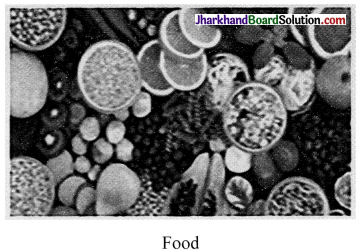



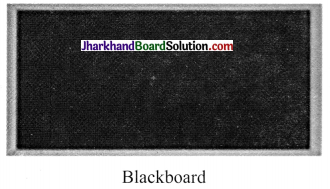
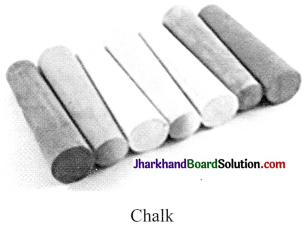
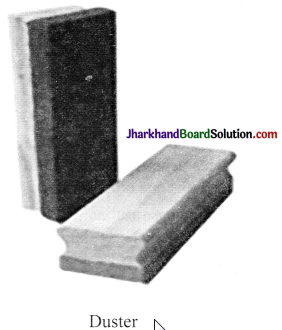


![]()
![]()

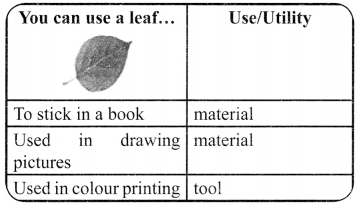
![]()
![]()
![]()
